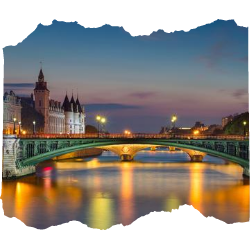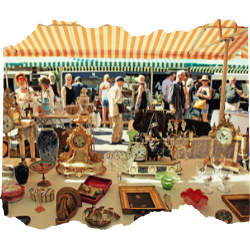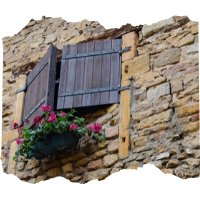Unsure about your French table manners? Click Here to download > > How to avoid these 10 food etiquette mistakes !
- Home ›
- Destinations ›
- Famous Landmarks in France
42 Famous France Landmarks (that define French history)
Updated 5 July 2023 by Leyla Alyanak — Parisian by birth, Lyonnaise by adoption, historian by passion
There are so many famous landmarks in France that I can't hope to visit them all – so I've asked others to share some of their favorites with you. I am trying to get to them all, though!
There are so many France landmarks important to history – iconic sights worth visiting – that to list them all would require days.
What follows is a curated list of some of the best landmarks in France. Many people visit these because of their tremendous beauty or unusual appearance, but if they're listed here, it's because they have something extra: they or their backstory have somehow been a part of French history.
My point here isn't to simply list them, but to provide a bit of context so that those of you who are interested in how the past informs the present can see what role the landmark played in it.
If I'm passionate about the history of my country, it's because everywhere I turn, there it is: the past walks beside us wherever we go.
NOTE: Pages on this site may contain affiliate links, which bring in a small commission at no cost to you.
COMING TO FRANCE? THESE RESOURCES CAN HELP!
🏨 Accommodation - I rent hotels quickly and easily through booking.com
🚘 Car rentals - I use Discovercars, Europe's best car rental website
🚊 Train tickets - I book my train and bus tickets on Trainline
🚌 Day tours - I take the best day tours with Viator and GetYourGuide
- 1. Amiens Cathedral
- 2. Arles Amphitheater
- 3. Avignon Papal Palace
- 4. Arc de Triomphe
- 5. Cap 110 Anse Cafard, Martinique
- 6. Carcassonne
- 7. Centre Pompidou
- 8. Château de Chenonceau
- 9. Château de Chambord
- 10. Château de Fontainebleau
- 11. Château de Villandry Gardens
- 12. Eiffel Tower
- 13. Fourvière Basilica, Lyon
- 14. Grosse Cloche, Bordeaux
- 15. Hospices de Beaune
- 16. Lascaux Caves
- 17. Les Invalides
- 18. Louvre Museum
- 19. Memorial Charles de Gaulle
- 20. Metz Cathedral
- 21. Meuse-Argonne American Cemetery and Memorial
- 22. Millau Viaduct
- 23. Miroir d'Eau, Bordeaux
- 24. Mont Saint-Michel
- 25. Musée d'Orsay
- 26. Nîmes Arena
- 27. Notre-Dame de la Garde Basilica, Marseille
- 28. Notre-Dame Cathedral
- 29. Notre-Dame de Strasbourg
- 30. Palais Garnier
- 31. Pantheon
- 32. Père Lachaise Cemetery
- 33. Place Stanislas, Nancy
- 34. Pont d'Avignon
- 35. Pont du Gard
- 36. Promenade des Anglais, Nice
- 37. Reims Cathedral
- 38. Royal Saltworks at Arc-et-Senans
- 39. Sacré-Coeur Basilica, Montmartre
- 40. Sainte-Chapelle
- 41. Trianon Estates
- 42. Versailles
Famous landmarks in France
I've added France's most visited monuments in alphabetical order (this article deals with man-made monuments, not natural landmarks).
I did try to organize them by region or type but the list never looked right, so I opted for simplicity. Use the table of contents above to navigate to your preferred landmark.
I've visited most of these landmarks myself, and those I haven't been to are written up by fellow travelers who have visited in person.
1. Amiens Cathedral
Amiens Cathedral, which recently celebrated its 8ooth birthday, is the largest cathedral in France. Notre Dame Cathedral could fit inside it, with room to spare.
But that’s not the only thing that’s special about this grand gothic structure: beyond being one of those fabulous French famous landmarks, the cathedral holds a surprising secret.
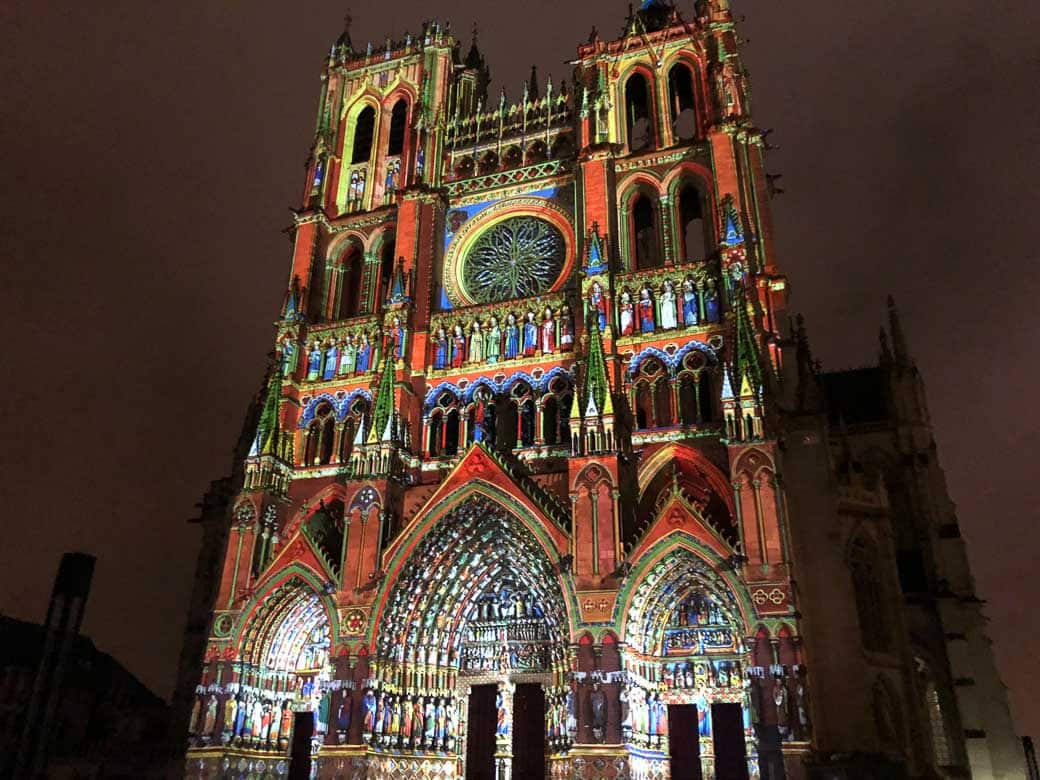 What the Amiens Cathedral MIGHT have looked like ©The Travel Bunny
What the Amiens Cathedral MIGHT have looked like ©The Travel BunnyWhen it was first built, the front of Amiens cathedral was painted in full glorious color. During renovations, traces of paint were found on the western façade. It was discovered that the cathedral’s intricately carved portals and grand statues were originally brightly painted.
You can see for yourself how it would have looked after nightfall when a spectacular light show projects the original colors onto the cathedral, bringing it to life. The fabulous sound and light show, Chroma ‘the Cathedral in Color’, takes place throughout the summer and again in December. As well as the original colors, geometric patterns and designs are projected onto the cathedral's exterior.
Stop off on your visit to northern France and see this stunning structure at it might have looked during the Middle Ages.
2. Arles Amphitheater
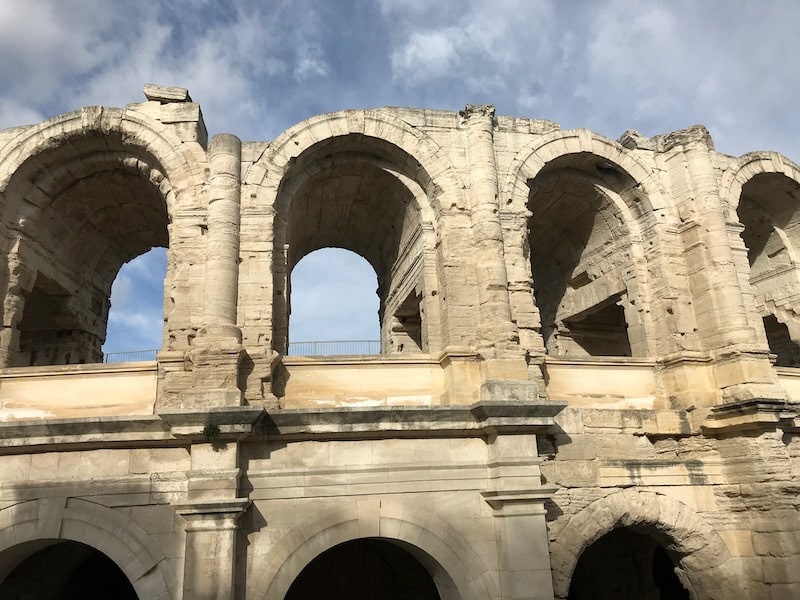 The Arles Amphitheater is a famous landmark in France dating back to the Roman era
The Arles Amphitheater is a famous landmark in France dating back to the Roman eraThe Arles Amphitheater, built in the first century CE, was where gladiator fights and chariot races were held, providing a regular dose of bloody sports to some 20,000 spectators. In later years, after the Romans had gone, buildings sprouted within the arena, turning it into a veritable village, replete with housing and churches.
While many other Roman structures were dismantled and their stones carted away for construction, the fact that the Arles Amphitheater served as a home to some may well have preserved it, making sure it wasn’t taken apart.
Walking around the arena, on a quiet day, you can almost imagine the crowds cheering as the gates opened, the lions burst forward, and the gladiators prepared to meet their fate.
3. Avignon Papal Palace
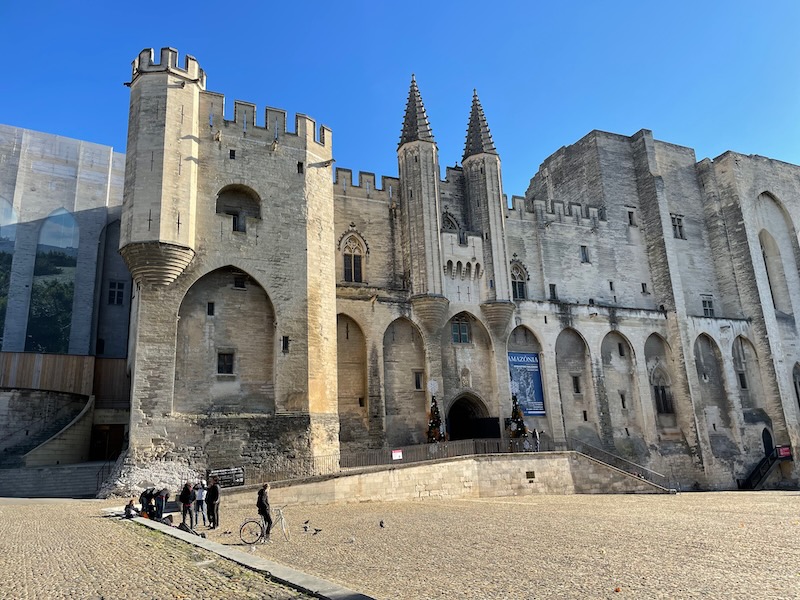 The Papal Palace hosted one of the Christianity's most unusual upheavals, making it one of the most Famous French buildings
The Papal Palace hosted one of the Christianity's most unusual upheavals, making it one of the most Famous French buildingsThe Palais des Papes, or Papal Palace, is one of the most famous French landmarks and the site of one of the stranger episodes in the history of both France and Christendom.
Medieval France and Italy both contained Papal States and popes weren't as stationary then – they traveled around Europe and resided in certain cities for a time.
Avignon was one of these papal states and would remain so until the French Revolution, when it became part of France.
Early in the 14th century, political turmoil in Rome led the pope, Frenchman Clement V, to make Avignon the papal seat, building the Papal Palace as both as a spiritual and strategic symbol overlooking the Rhône.
Seven popes would rule during the Avignon years, transforming it into a cosmopolitan city under what came to be known as the Babylonian Captivity of the papacy.
Today, the palace – the largest gothic building of the Middle Ages – is one of those historical places in France which is on the UNESCO World Heritage list. Get a skip the line ticket and take a walking tour of Avignon.
4. Arc de Triomphe
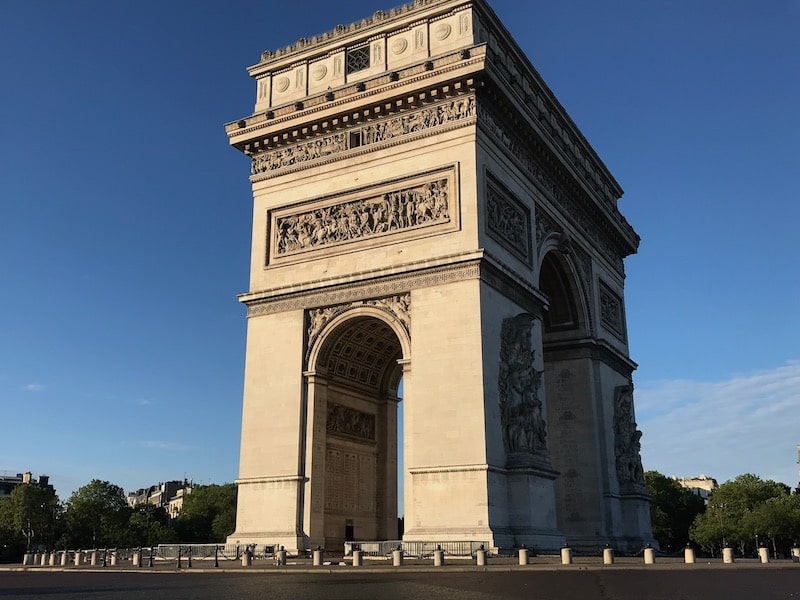 Arc de Triomphe taken from the side in the early morning, before the crazy traffic starts
Arc de Triomphe taken from the side in the early morning, before the crazy traffic startsOne of the iconic historical monuments in Paris, the Arc de Triomphe commemorates Napoleon's victory at Austerlitz.
The Arc de Triomphe is at the center of Place Charles De Gaulle (more commonly known as the Place de l'Étoile) in the 8th arrondissement, which marks the west end of the Champs Elysées and connects all 12 major avenues in Paris.
The junction of these avenues created a star: the official name of this landmark is the Arc de Triomphe de l’Étoile, which translates as Triumphal Arch of the Star and is one of the most recognizable monuments of France.
Construction, which was inspired by the Arch of Titus in Rome, began in 1806 and lasted 30 years. Napoleon I wanted to honor the victory of France's soldiers against Russia and Austria.
The names of 660 French generals, marshals and assorted officials, along with those of 128 victorious battles of the Revolution and the Napoleonic Wars, are inscribed on the arch's outer and inner surfaces. If names are underlined, it means they died in battle. And several of Napoleon's own relatives have their names here, of course.
What you may not know is that since 1920, the tomb of the Unknown Soldier lies beneath the arch, symbolizing those who died fighting World War I. The arch also harbors the eternal flame, which commemorates all soldiers who died in battle. It is lit every evening in remembrance, making it one of the most revered landmarks in Paris, France.
You shouldn't miss going up top – there is an interesting little display (I can't really call it a museum) but it does have one of the best views ever of the French capital.
See Paris from the top of the Arc de Triomphe!
5. Cap 110 Anse Cafard, Martinique
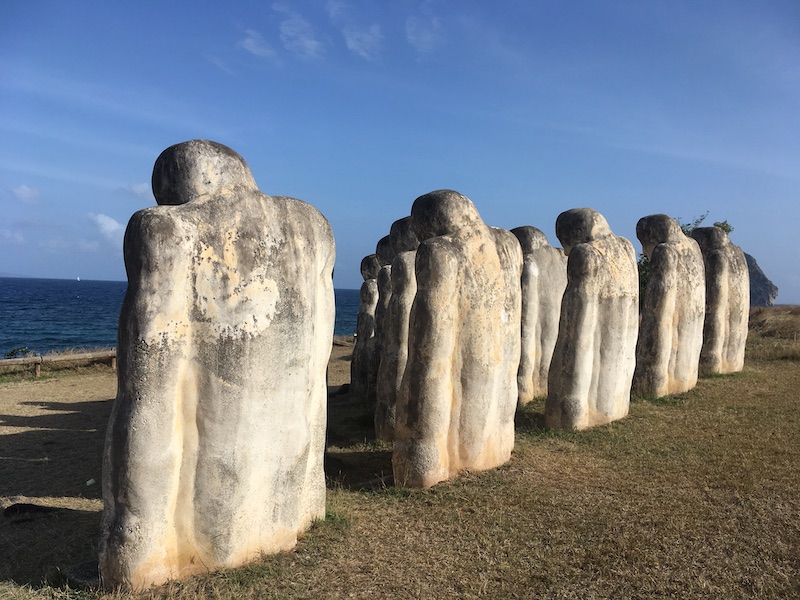 Cap 110 Anse Cafard, Martinique, one of the major landmarks in France overseas ©A Social Nomad
Cap 110 Anse Cafard, Martinique, one of the major landmarks in France overseas ©A Social NomadFrance is much more than its mainland and in the Caribbean, on the French Antilles island of Martinique, the memorial at Anse Cafard is a stunning monument that commemorates a mystery ship.
In 1830, a slave ship carrying 300 slaves sank off the Diamante coast of Martinique. Yet France had banned slave trading 1817. What was this ship? Who was her crew? Where did she come from?
No documentation was ever found about the vessel, and no crew members survived, although 60 women and 26 men – all slaves – were rescued. The bodies of the recovered crew were buried in the local graveyard, the slaves near the shore of the Anse Cafard beach.
The memorial at Anse Cafard was unveiled on the 150th anniversary of the abolition of slave trading. It commemorates not only those lost on the mystery ship, but also those who lived and died as slaves. The white concrete busts of men set in a triangle represent the triangular slave trade between Europe, Africa and the Americas. In the Caribbean, white is the colour of mourning. The orientation of the busts, 110° East, represents the direction of the Gulf of Guinea, where the stricken vessel is likely to have originated.
While the memorial is visually striking, the stories presented on the information boards are indelibly memorable.
6. Carcassonne
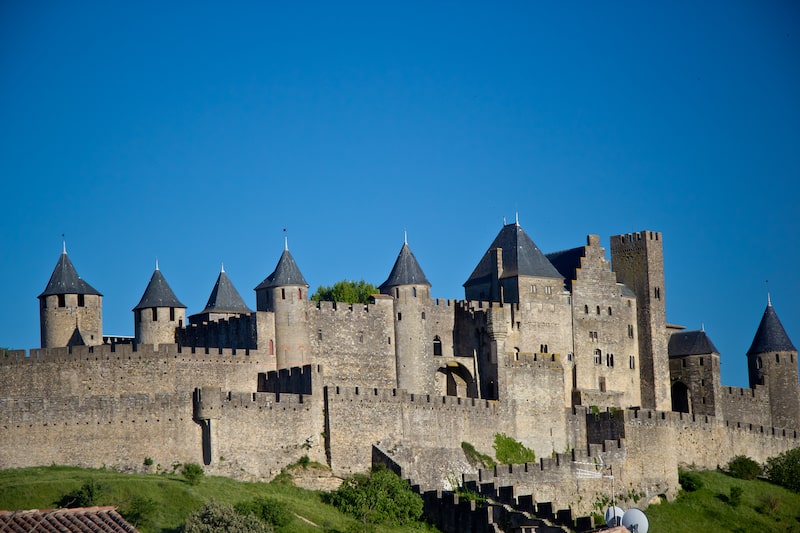 The medieval city of Carcassonne, stunning from any direction
The medieval city of Carcassonne, stunning from any directionThe walled (double-walled) Cité de Carcassonne is an extraordinary example military architecture from the Middle Ages.
Carcassonne was a stronghold for centuries, and withstood a number of sieges over the years. But in time, as borders shifted, the city became less strategically important and eventually began to deteriorate.
At one point, the government decided to raze it (can you imagine?) but there was an uproar and local authorities campaigned for its preservation, led by architect Eugène Viollet-le-Duc. The work was highly controversial and its historical accuracy was contested, but it probably saved the city from ruin.
Today, Carcassonne is a UNESCO World Heritage Site and one of France's favorite tourist attractions. And while it might be historically deviant, you’d never know it from the more than 50 towers and barbicans that connect its walls.
7. Centre Pompidou
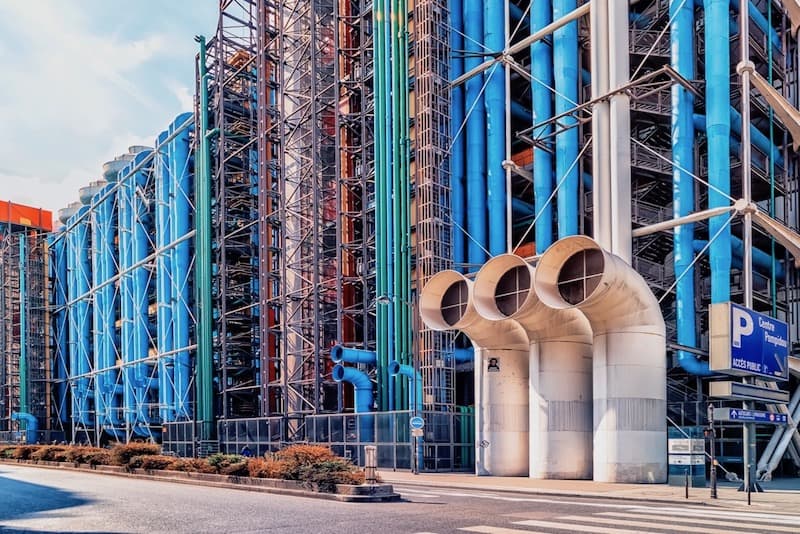 The Centre Pompidou, yet another controversial French landmark
The Centre Pompidou, yet another controversial French landmarkThe Centre Pompidou was inaugurated in 1977, but not before it set many tongues wagging, confirming that Parisians don't seem to take instantly to what is modern.
The peculiarity of this building is that it is turned inside out: all the pipes, conduits and shafts are placed outside the building rather than inside, as is usual.
They said it was ugly; it was too long/wide/tall; it cost too much; it's not a museum, 'only' a cultural center.
In other words, the traditionalists and modernists were at it again and the controversy made it one of the most famous buildings in France.
Detractors called it Notre-Dame of the Pipes, the Pompidolium, or again, the Steamship of Culture, none too flattering.
Yet on inauguration night, people were paying top dollar (or franc) for the rare tickets.
Like the Eiffel Tower before and the Louvre pyramid afterwards, everyone found fault with it, until they didn't.
8. Château de Chenonceau
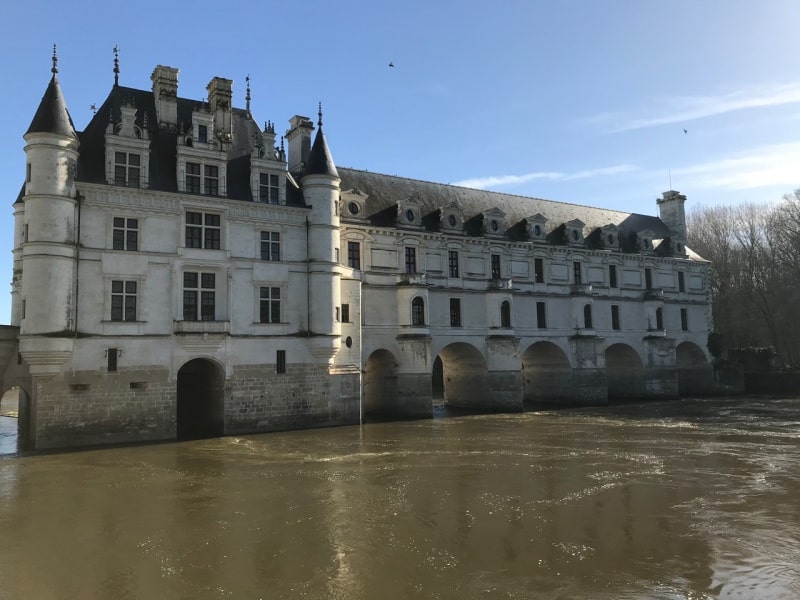 Chenonceau, the Ladies' Castle; this château is one of the most popular in France
Chenonceau, the Ladies' Castle; this château is one of the most popular in FranceChenonceau is the Loire Valley's best known and most visited château, one of the most famous buildings of France.
It is commonly known as the Ladies' Castle, because women have been involved throughout its history: a woman built it (Catherine Briçonnet, wife of a royal financial superintendent), another woman embellished and expanded it (Henri II’s mistress Diane de Poitiers), and yet another reclaimed it (Catherine of Medici, Henri II's wife – she was not amused when her husband gave it to his mistress, even though she did get in the end).
Clearly, there was no lack of intrigue!
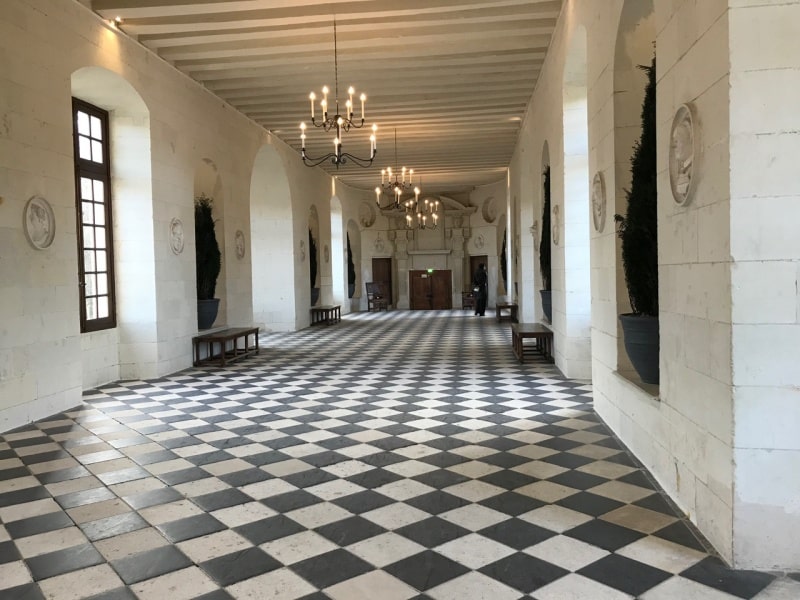 Chenonceau's Grande Galerie ©Offbeat France
Chenonceau's Grande Galerie ©Offbeat FranceAnd then there's the Grande Galerie, the lovely bridge over the River Cher, with so much history you can almost see the ghosts floating out of its alcoves.
Remember Mistress Diane? She expanded Chenonceau by building a bridge over the river (she liked to go hunting on the other shore). But once Catherine of Medici got her château back, she covered the bridge and built the gallery, where she would hold many a party.
Eventually, during World War II, it became a military hospital. As it happened, the demarcation line between Nazi-occupied and Free France ran right down the middle of the Cher River. The château's owners (the Meniers, who still own it), smuggled Jews and others fleeing the Nazis through the gallery and out the other side into freedom.
Such a small space for the Gallery – 60 x 6 meters (200' x 20') – but so much history! And this is one castle that deserves a photography tour.
9. Château de Chambord
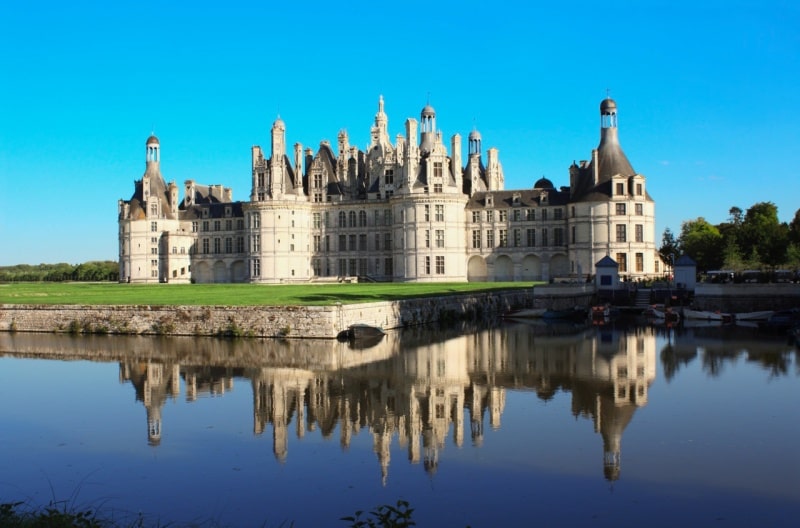 Château de Chambord, one of the most famous French castles, and certainly the largest one
Château de Chambord, one of the most famous French castles, and certainly the largest oneChambord, as we know, is the largest of the giant châteaux in the Loire Valley, built as a "humble" hunting lodge by François I, he who loved to build.
Picture this: a mixture of medieval and Renaissance with 440 rooms, 282 fireplaces and 80 or so staircases, including the famous double-helix which some believe may have been inspired by Leonardo da Vinci, a friend of the king.
In those days, the royal court was itinerant and didn't stay put: every few months, the king and his retinue moved from château to château, so don't be surprised at the lack of furniture in Chambord. This was never a home, just a stop along the way, and François would spend a grand total of 60 days here during his lifetime.
You can tell all this by Chambord's interior – cavernous, bare, and in winter, freezing. Decor and comfort were not priorities here, at least not in the early days (building lasted from 1519 to 1547) and it would take years for lavish furnishings to appear.
While Chambord was surrounded by superb hunting grounds, the choice of a marsh on which to build it has always been shrouded in a bit of mystery, being so far from Paris and its politics. Esoteric writers throughout the times have seen fit to find hidden meanings throughout Chambord, from its sublime symmetry to the repeated us of the number eight.
If you're visiting from Paris, you might enjoy a day tour to Chambord, Chenonceau and Amboise from Paris.
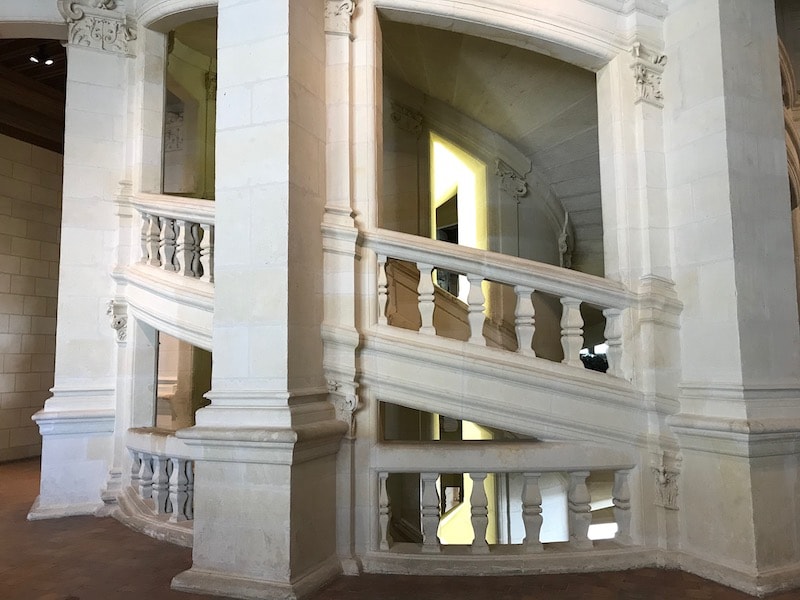 Chambord's famous double helix stairway - two people can go up and down without ever running into one another ©Offbeat France
Chambord's famous double helix stairway - two people can go up and down without ever running into one another ©Offbeat France10. Château de Fontainebleau
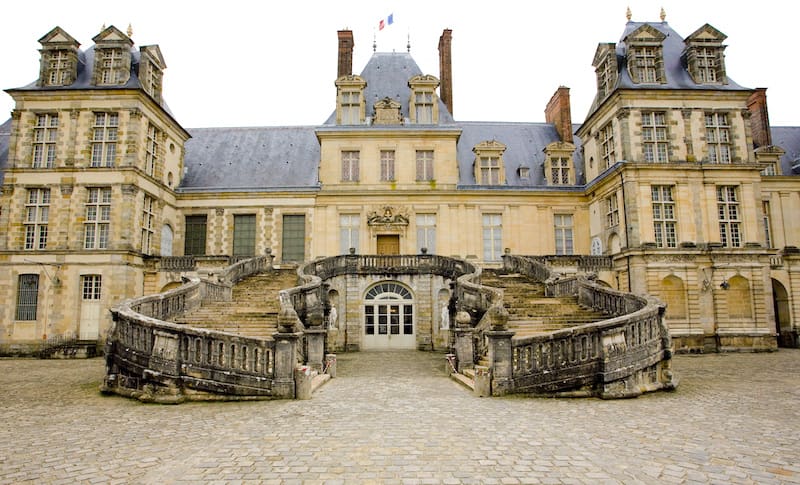 If these iconic stairways look familiar, it's because they've been used as film locations, for example in Marie-Antoinette, and the Man in the Iron Mask
If these iconic stairways look familiar, it's because they've been used as film locations, for example in Marie-Antoinette, and the Man in the Iron MaskSo many monarchs have been linked to Fontainebleau, southwest of Paris! There’s little in French history that isn’t somehow connected to this château.
Fontainebleau burst onto the royal scene at the hands of François I, the builder king, who turned what had been a medieval fortress into an Italian-style palace, having come to love this style during his military campaigns in Italy. He would invite Italian artists to come to France (he would later invite Leonardo da Vinci to spend his final days in France) and decorate his new venture.
Many French kings would be born here, and would use Fontainebleau to get away from the strictures of Versailles. And it wasn’t just kings: Napoleon would live here, and abdicate here.
The last monarch to inhabit the palace would be his nephew, Napoleon III, making it the only chateau to be inhabited by monarchs non-stop for eight centuries.
11. Château de Villandry Gardens
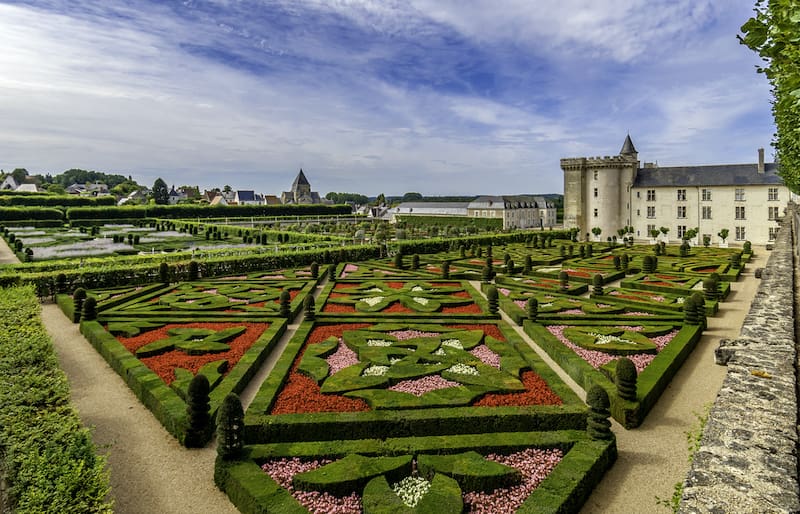 The stunning geometric patterns of the gardens of Villandry
The stunning geometric patterns of the gardens of VillandryOne of the most beautiful gardens of the Loire Valley castles belongs to the Château de Villandry, built in 1532 and extensively renovated from the 18th century onwards.
In 1906, Villandry – having changed hands many times over the years – was purchased by an illustrious Spanish doctor and his American wife, Ann Coleman. She and Dr Joachim Carvallo would spend the rest of their lives restoring the castle and bringing the gardens back to their Renaissance origins.
Carvallo started with the Vegetable Garden, closest to the castle, planting vegetables chosen for their colour and shape so that they resemble geometric works of art.
He hid allusions to his homeland throughout the gardens: the Cross of the Basque Country in the Garden of the Crosses, the figures formed by the boxwoods in the four Gardens of Love, or the details of the pergolas.
Anyone who has ever had even the tiniest plot can admire the planning and hard work that goes into delivering such horticultural perfection. This is a popular venue so make sure to get your skip-the-line ticket for Villandry here.
12. The Eiffel Tower
 The Eiffel Tower became one of the most famous places in France as soon as it was built - first because of the controversies around it but the, but then because of its distinguished contribution to the Paris skyline ©Offbeat France
The Eiffel Tower became one of the most famous places in France as soon as it was built - first because of the controversies around it but the, but then because of its distinguished contribution to the Paris skyline ©Offbeat FranceIf you've ever heard the question "What is France famous for?" someone is sure to pipe up, "the Eiffel Tower"!
Indeed. But what if... instead of being called the Eiffel Tower, it had been called the Bönickshausen Tower?
It easily could have happened.
The tower's builder, Gustave Eiffel, was born with a different last name: Bönickshausen. His father had been a military officer of German origin but in 1877, in the wake of France's defeat in the Franco-Prussian War, Gustave officially changed his name to avoid being tainted as a Prussian spy.
Of course by the time the tower was built, Bönickshausen had been replaced by Eiffel.
Love it or hate it, the Iron Lady – built to commemorate the French Revolution's centennial – has towered over Paris since the 1889 World's Fair, making the city instantly recognizable as one of the most famous places in Paris (and one of the most famous landmarksin France).
Like the Louvre pyramid and the Centre Pompidou, the Eiffel Tower started life being hated. Initially, most people disliked it, calling it an abomination or a monstrosity (these were some of the more polite epithets). In fact, it was only tolerated because it was meant to be temporary.
Engineer Eiffel may have thought he was pulling Paris into the 20th century, but many Parisians disagreed, and it took time for the city to first accept it, and finally, to adopt it. Today, Paris wouldn't be Paris without it.
Make sure you book your ticket for the Eiffel Tower ahead of time!
13. Fourvière Basilica, Lyon
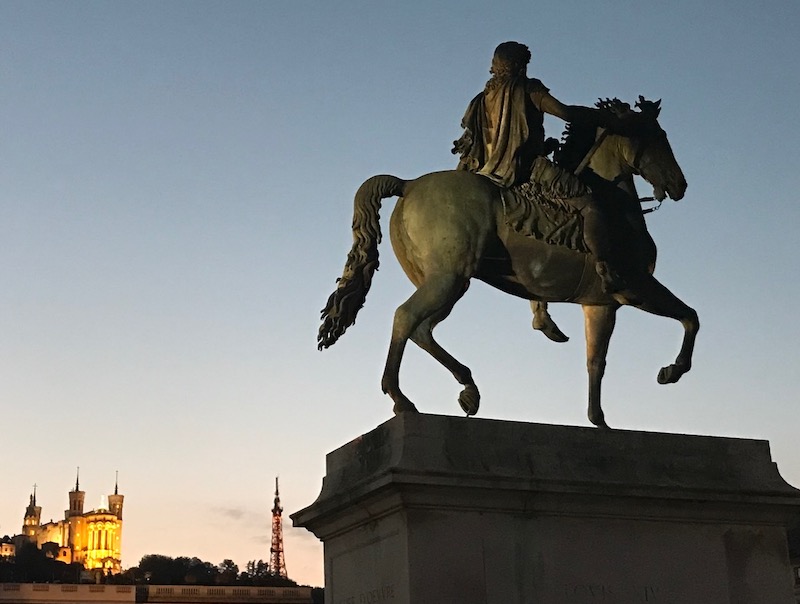 Three famous monuments in France: in the foreground, an equestrian statue of Louis XIV on Place Bellecour; above left, Fourviere Basilica; and next to it, the mini-Eiffel Tower ©OffbeatFrance
Three famous monuments in France: in the foreground, an equestrian statue of Louis XIV on Place Bellecour; above left, Fourviere Basilica; and next to it, the mini-Eiffel Tower ©OffbeatFranceLyon is a much underrated city, yet oh-so-worthy of a visit.
It has some of the most stunning murals in France, and is filled with secret passageways, or traboules, that allowed silk workers laden with bolts of silk to run down Croix-Rousse hill and avoid the rain.
It has one of the quirkier landmarks of France, the Fourvière Basilica, which guards the city from above, with its mixture of byzantine, gothic, romanesque... and some would even say Moorish styles, not to mention the panoramic view of Lyon you'll get from its lookout. It is one of the most famous buildings in Lyon.
Before it was a basilica, a Roman forum stood here. Lyon, or Lugdunum as it was then called, was Rome's regional capital.
Next to the basilica you can see a metallic tower, which looks tauntingly like a little Eiffel Tower. At 85 meters (278 ft), a quarter of the Eiffel Tower's height, it is a replica of the Paris tower's top third.
Given the resemblance, it's no surprise there are plenty of stories about this little tower.
One story gives authorship of the little tower to Gustave Eiffel himself, but few people believe this.
In another story, it becomes a "republican" monument that offsets the religious nature of the basilica next door. There isn't much truth to this one either.
Here's one that is equally false but somehow more plausible: originally designed to compete with the Eiffel Tower, the city authorities eventually ran out of funds or interest... and stopped. But in 1914, during Lyon's World Fair, it even had a little elevator to take people to the top. Just like the Big One in Paris. It may also have been designed as a restaurant...
These days, it is the highest point in the city and serves as an antenna and broadcast center.
Reserve your entry ticket here (site in French)
14. Grosse Cloche, Bordeaux
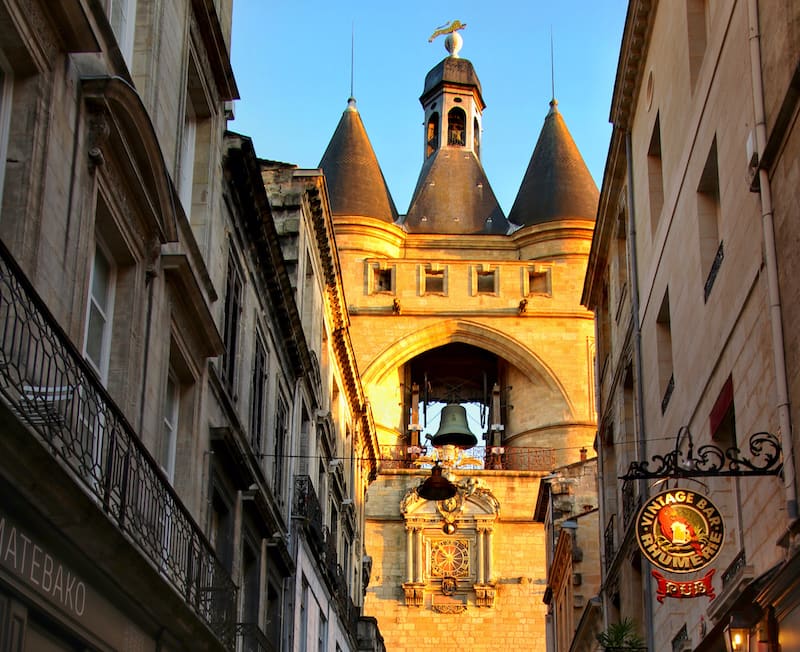 The Grosse Cloche, one of the most famous Bordeaux landmarks ©Luxe Adventure Traveler
The Grosse Cloche, one of the most famous Bordeaux landmarks ©Luxe Adventure TravelerAnother French landmark of note is Bordeaux's Grosse Cloche. It is one of the oldest belfries in France and one of the most recognizable landmarks in Bordeaux, even featuring on Bordeaux's coat of arms.
The belfry was built from the 13th century remains of the Porte Saint-Éloi, which was one of the main gates to medieval fortified Bordeaux. The Grosse Cloche also marks the Saint James Way, or Camino de Santiago, on the way from Paris.
Needless to say, it's got a lot of history that makes the Grosse Cloche well worth a visit.
Just passing beneath, you might not notice the massive bell. The 2-meter wide bell, cast in 1775, weighs in at an impressive 7800 kilograms (8.5 US tons). It's so massive, in fact, that when the bell is rung, it actually rattles the windows of the neighborhood. The distinct, deep gong can be heard throughout the entire city. But you'll have to visit Bordeaux at exactly the right time to hear it.
It's only rung on a handful of occasions: the first Sunday of each month, January 1, May 8, July 14 for Bastille Day, August 28 which marks the 1944 liberation of Bordeaux, and November 11.
Even in the bell's heyday, it wasn't just rung to mark the hours like the bells of the cathedral or Hôtel de Ville. The bell of the Grosse Cloche has always been rung only on important occasions like to mark the start of the wine harvest, or in extreme emergencies such as a fire or attack on the city.
The bell is undoubtedly a treasure of Bordeaux. Because they were so proud of it, King Henry II confiscated the bell to punish Bordeaux for their revolt of the Pitauds in 1548. As a reward for good behavior, the bell was returned to the Bordelais in 1561.
There's one other quirky feature of the Grosse Cloche. Look at its south-facing side and you'll notice it has two clocks on it. The two clocks weren't always there, though.
It's thought the second clock was added around the early 1900s when a new time system was implemented throughout Western Europe to unify time in the continent's major cities. Mainly, managing train schedules needed to be simpler.
One clock displays the new time system, and the original clock with its half face displays the solar time.
See the Grosse Cloche during a Bordeaux City walking tour.
15. Hospices de Beaune
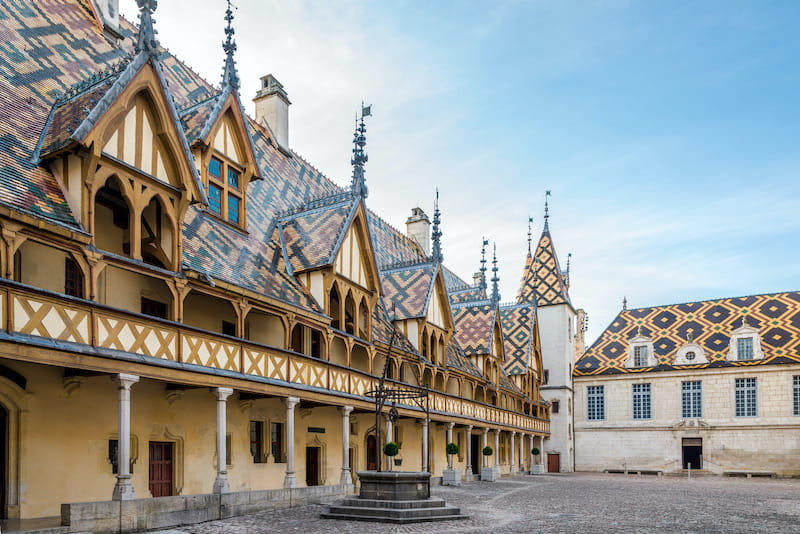 The Hospices de Beaune is one of the more famous buildings in France because of its glazed tile roof
The Hospices de Beaune is one of the more famous buildings in France because of its glazed tile roofThis former hospital for the poor was built in 1443, a jewel of medieval Burgundian (and very gothic) architecture. Think about it: the first patient was admitted here 40 years before Columbus arrived in America, and the last patient would leave in 1982...
The Hotel-Dieu of the Hospices de Beaune is part of a health complex and now manages the Domaine des Hospices de Beaune winery and its world-famous yearly auction. The auction takes place each year, on the third Sunday of November, and is one of the most prestigious dates on the world's wine calendar. Much money changes hands, all the more because the proceeds go to charity.
The building's outstanding architectural feature (in my humble opinion) is its roof, covered with the well-known tiling called ‘tuile vernissée de Bourgogne’, or varnished Burgundy tile, so typical of this region in East-Central France.
Few workshops still manufacture these tiles. Each is covered in a salt-based coat to which lead or pewter are added. This changes the tile's color during baking.
Each tile is baked twice and the second time around, the salt melts, giving the tiles their ‘iced’ look. The use of different varieties and amounts of salt contribute to changing the coloring.
Check out these Burgundy wine tours that include a stop at the Hospices.
16. Lascaux Caves
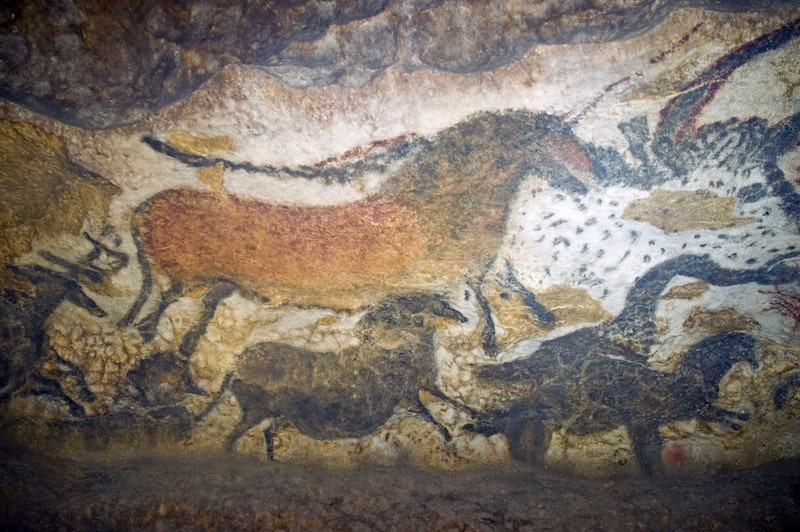 Cave paintings at Lascaux, remarkable even after 20,000 years
Cave paintings at Lascaux, remarkable even after 20,000 yearsLascaux, sometimes referred to as the 'Sistine Chapel of cave art,' is a wonder of prehistoric artistry located in the Dordogne region. The wall paintings are believed to have been crafted between 17,000 and 20,000 years ago, providing a snapshot of the prehistoric world – or how it was imagined at the time.
Rather than painting the everyday animals they hunted, like sheep and fish, the artists of Lascaux painted creatures that may have inspired fear and awe – the bison, aurochs, and other large game.
These paintings remain mysterious, as much for their subjects as for the reasons they were etched and the identity of their artists.
17. Les Invalides
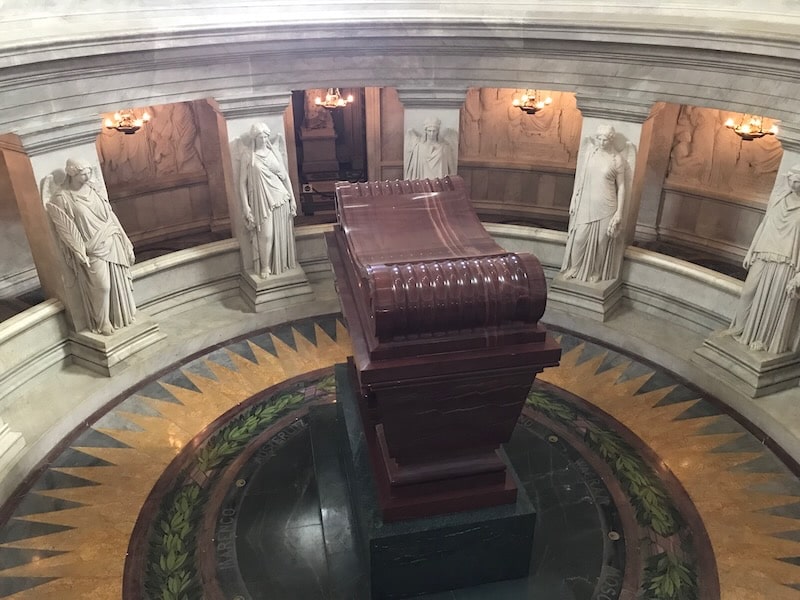 Napoleon's tomb in the Invalides
Napoleon's tomb in the InvalidesThe Hôtel des Invalides in Paris isn’t a hotel at all, but a complex built by Louis XIV as a home for veterans. You can easily recognize its characteristic golden, under which Napoleon Bonaparte is buried.
His is quite the tomb: red quartzite on a base of green granite, surrounded by a mosaic containing the names of Napoleon’s war victories. His tomb is made of five coffins, each of different material, and 12 white marble statues, called Victories, watch over him.
A few other members of the imperial family are buried here, including his younger brother, his older brother, and his son, who died at 21, extinguishing Napoleon’s dynastic dreams.
18. Louvre Museum
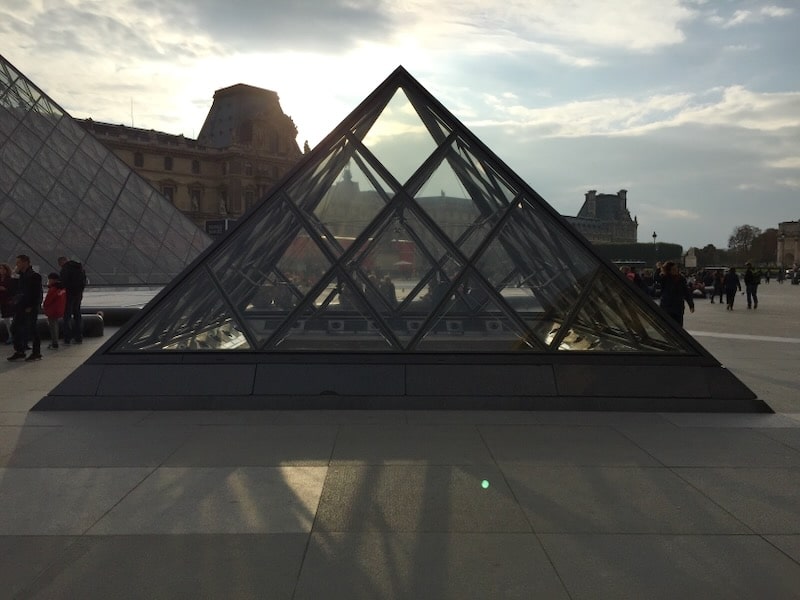 The Louvre, one of the most famous museums in France (arguably THE most famous), superb from every angle: architecturally, artistically, historically
The Louvre, one of the most famous museums in France (arguably THE most famous), superb from every angle: architecturally, artistically, historicallyNot long after the Centre Pompidou, one of the most famous landmarks in Europe, the Louvre Museum, was to be modernized, again striking fear into Parisian hearts.
When the new design (by I.M. Pei) was first shown to the French, emotions evolved quickly: disbelief at first, followed by disgust. Then, the immediate commentaries: it was ugly; it was anti-French; it was a symbol of death (in Egypt, anyway); it was a rupture with history. Some even called it sacrilegious. And so on.
Starting to sound familiar?
Still today, this bucket list item has detractors, although most Parisians have learned to live with it. For others, it has become the monument of France they cherish the most.
As for the museum itself, it is an icon France is famous for: the largest museum in the world, and home of such revered artworks as the Mona Lisa, the Venus de Milo, and the Winged Victory of Samothrace.
The building actually started life as a fortress, became a royal palace, and remained a royal residence until Louis XIV moved the entire French court to Versailles.
Skip the line at the Louvre and head straight in!
19. Memorial Charles de Gaulle
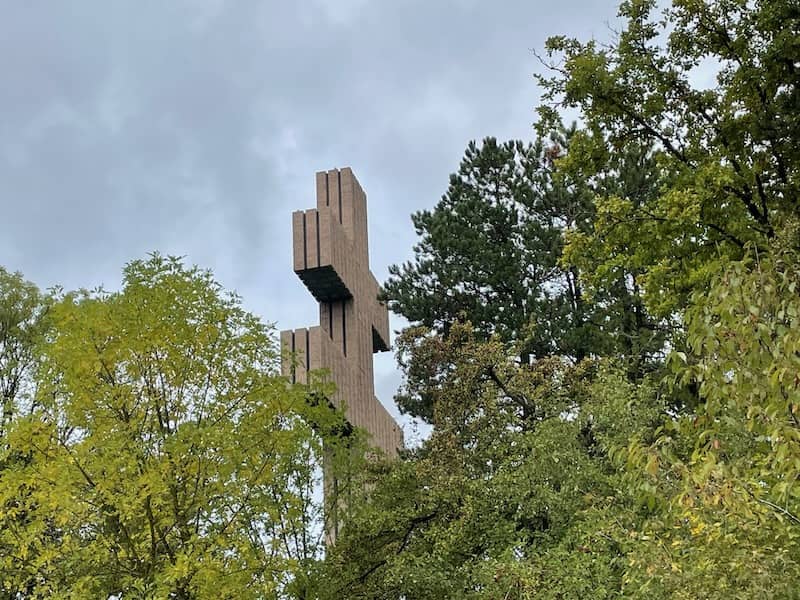 The enormous Croix de Lorraine, peeking through the trees at Colombey-les-Deux-Eglises
The enormous Croix de Lorraine, peeking through the trees at Colombey-les-Deux-EglisesAlong with Napoleon and Louis XIV, Charles de Gaulle is possibly France's best-known citizen.
A career military man, he rebelled against the Vichy regime's appeasement of Germany during World War II. He fled to London, where his BBC broadcasts rallied the nascent French Résistance against Nazism.
After the war, he became President of France and when he died, a massive cross, the Croix de Lorraine, was erected near his home in Colombey-les-Deux-Eglises in northeastern France.
Behind the cross is a massive memorial museum that retraces De Gaulle’s life: he lived through two world wars, and presided over the birth of France's Fifth Republic and its new constitution. Both French monuments are emblematic of the country's 20th-century history.
20. Metz Cathedral
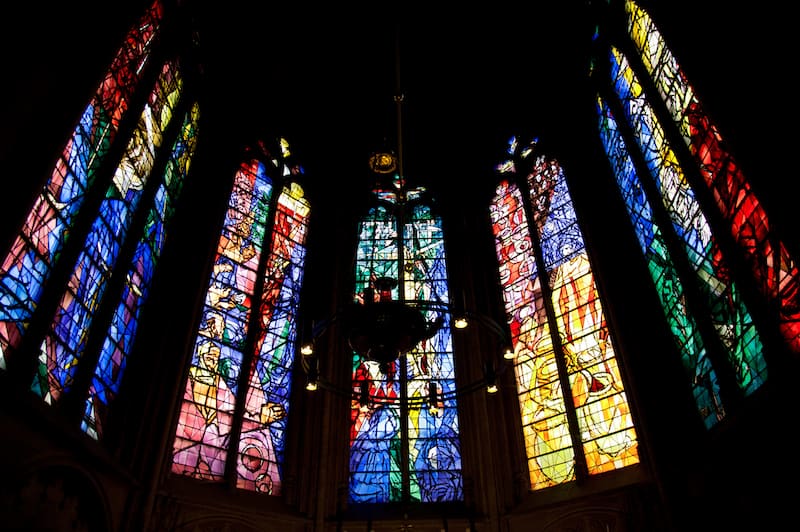 Stained glass windows inside Metz Cathedral
Stained glass windows inside Metz CathedralThis Gothic cathedral, which took three centuries to build from the 13th to the 16th, has one of the highest naves in the world – 42 m / 138 ft. It’s been nicknamed 'The Good Lord's Lantern’ because of its imposing silhouette.
The cathedral is also famous for the size of its stained glass windows, which cover one of the largest surfaces of stained glass in Europe. The windows include remarkable pieces designed by renowned artists like Marc Chagall and Jacques Villon, and the play of light inside the cathedral is breathtaking.
21. Meuse-Argonne American Cemetery and Memorial
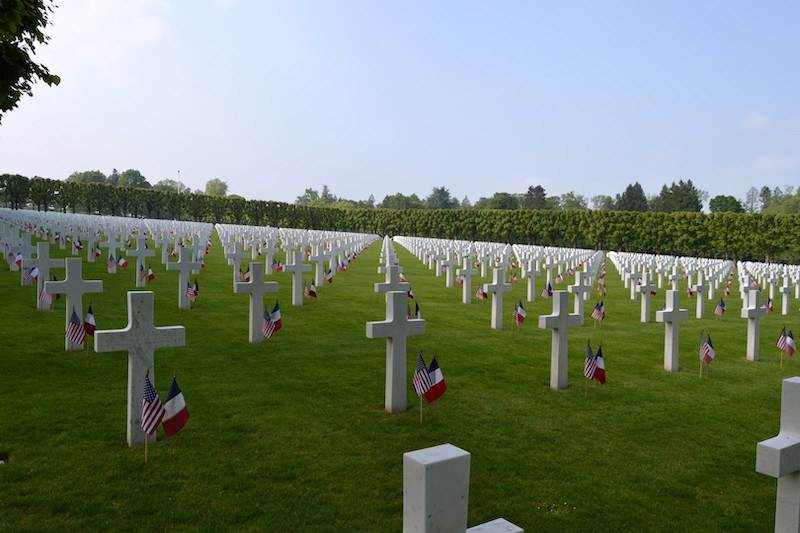 The Meuse-Argonne American Cemetery and Memorial ©LeAnna Brown
The Meuse-Argonne American Cemetery and Memorial ©LeAnna BrownWhile many people pay their respects to the men and women lost during D-Day at places like Normandy, it is not even the largest American cemetery in Europe.
That title belongs to the Meuse-Argonne American Cemetery and Memorial, located in northeastern France, an area enriched with decades of history.
Over 15,000 soldiers lay at rest in this pristine cemetery, their tombs stretching as far as the eye can see, each with a carefully placed American and French flag to symbolize the relationship between the two countries.
For history lovers, a trip to this location is somberly paired with other nearby World War II memorials and sites such as Fort Douaumont, Butte De Vauquois, Montfaucon D'Argonne, and the Verdun Citadel, making it an ideal, yet off the beaten path location for history buffs.
One of the most powerful times to visit this cemetery is on the American Memorial Day holiday, each year on the last Monday of May. Americans and French perform a beautiful ceremony in honor of all the lives lost during World War II, particularly those forever placed in this location.
As you wind through nearby villages, you may be surprised to see that gratitude towards American lives on. Nearly 80 years later, "Thank You" signs and US flags still permeate the countryside...
Visit the WWI cemeteries on a day trip from Paris.
22. Millau Viaduct
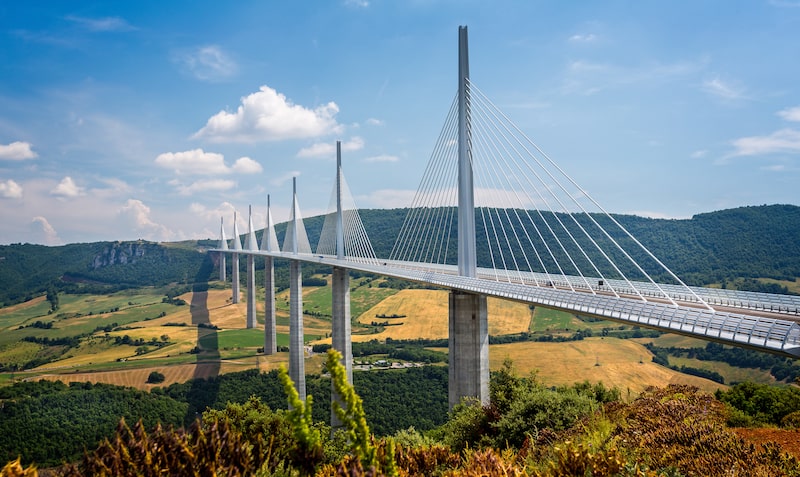 The Millau Viaduct, a French engineering feat in the Aveyron
The Millau Viaduct, a French engineering feat in the AveyronThe Viaduc Millau is one of the famous structures in France for its engineering prowess. Also known as the Suspended Bridge or Bridge in the Air, it spans more than 300 metres across the French River Tarn near the town of Millau. It is one of the world's longest multi-span cable-stayed bridges.
This architectural wonder is not one of your typical famous French places but it is nonetheless worth the detour. It was built to withstand earthquakes of up to 8 points on the Richter scale, and was designed by Michel Virlogeux and English architect Norman Foster, with help from prestigious engineering firms.
The tallest tower of the viaduct is 336 meters (1100 feet) high, making the Millau Viaduct France's tallest bridge and the 26th highest in the world.
The bridge cost 400 million euros to build and costs 10 euros to cross.
Find out more about the Millau Viaduct.
23. Miroir d'Eau, Bordeaux
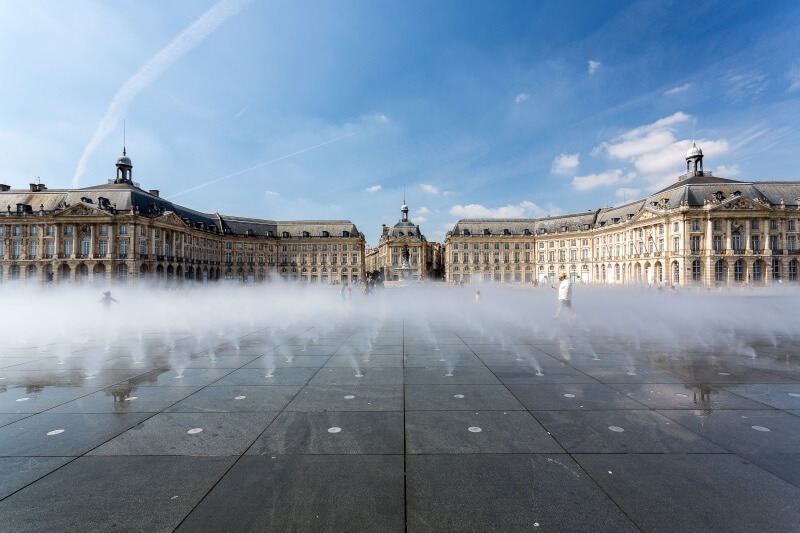 The Miroir d'Eau in Bordeaux ©Steve Le Clech Photos
The Miroir d'Eau in Bordeaux ©Steve Le Clech PhotosKnown as the Water Mirror, this is the world’s largest reflecting pool and has become the city’s emblem, which everyone now identifies with Bordeaux.
Built in 2006 to revitalize Bordeaux’s left bank, the mirror stands over the world’s largest underground water reservoir. The water turns on for 15 minutes, then off for five, and then the finale: five minutes of rising mist, ideal in summer and a symbol of the new, cleaner, brighter Bordeaux.
Beyond the Miroir d'Eau, you can glimpse what is left of the original square, the Place de la Bourse. Built under Louis XV to "open up Bordeaux" and free it from its walls, its centerpiece was designed to be a royal equestrian statue. Then the French Revolution came, and the statue was briefly replaced by a Liberty Tree, itself replaced by the Fountain of the Three Graces which stands today.
24. Mont Saint-Michel
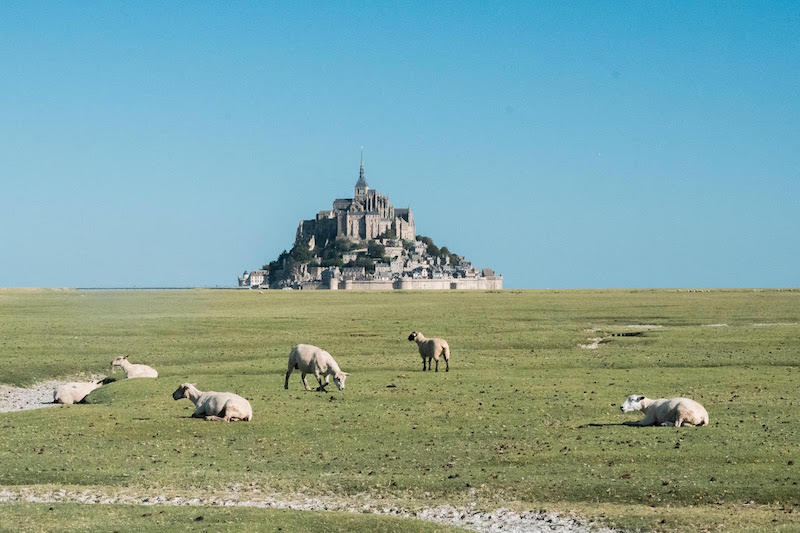 The changing faces of Mont Saint Michel ©Guide Your Travel
The changing faces of Mont Saint Michel ©Guide Your TravelMont Saint-Michel is an incredibly popular tourist attraction, but that doesn’t mean it isn't still hiding secrets. It may well be the most recognizable France landmark outside Paris.
It is crowned by an abbey, clothed in a legend... which states that sometime during the 8th century, the Archangel St Michael visited the local archbishop, ordering him to build an abbey. The archbishop acquiesced, the abbey was built, and it became a magnet for pilgrims from all over northern Europe.
For a dozen centuries, until the French Revolution, pilgrims were the main visitors. But where pilgrims alight, you also need people to supply food, lodging, horses, wood for carts… so the town grew.
The abbey also had another function: it had held prisoners for many years but in 1810 it became a full-fledged prison, losing any religious significance as the Revolution swept such things away.
And so it remained for 50 or so years, filled with intellectuals and political prisoners, until Napoleon III (nephew of the first) shut it down. Eventually, the rock was joined to the mainland by a steam tram and pilgrimages resumed. It wasn’t until the 1960s that monks returned to the abbey.
Its bay has Europe’s biggest tides and walking to the rock, with little knowledge of local tides, was once a life-threatening undertaking. Even in modern times, many a visitor has had to call for help after being stranded by the tides. Today, a walkway on stilts lets you amble along the 2.5km in safety.
Here are some of the ways to get to Mont Saint-Michel.
Consider a private walking tour of Mont Saint-Michel to get the most from your visit.
25. Musée d'Orsay
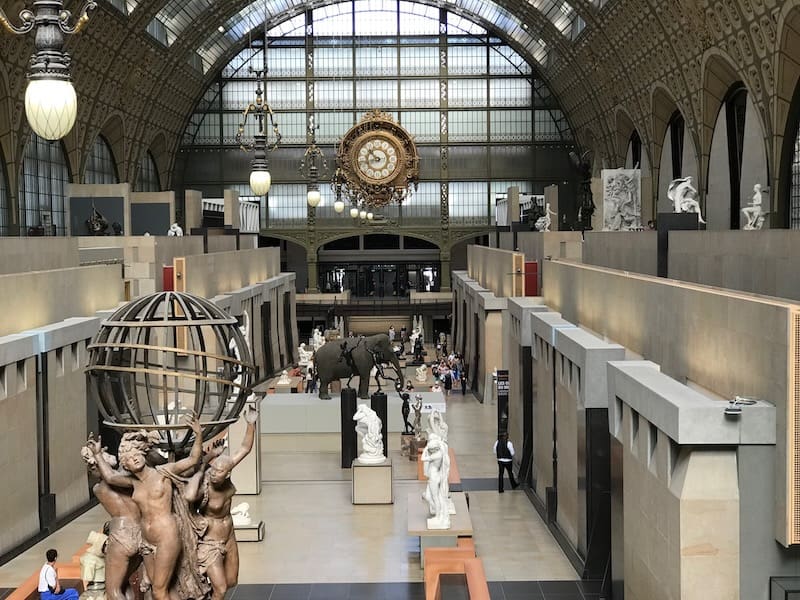 The Musée d'Orsay was once a train station and is now one of France's most loved museums
The Musée d'Orsay was once a train station and is now one of France's most loved museumsThe Musée d'Orsay came close to disappearing. Originally built as a train station for the Universal Exhibition of 1900, it was turned into a railway station for trains from southwestern France but only for 40 years.
After that, it was in limbo for half a century. Several projects were designed to either change or safeguard this stunning neoclassical structure. None succeeded (for which we should be grateful) and the station was repurposed into a museum in 1986.
As a museum, the Musée d'Orsay showcases French art of the Second Empire and the Belle Epoque, with a vast collection from artistic movements that include Impressionism, Post-Impressionism, Art Nouveau, and Symbolism. The works at the Orsay fill a gap between the more classical Louvre and modern Pompidou Center, with such celebrated artist as Cézanne, Degas, Manet, Monet, Renoir, and Van Gogh.
26. Nîmes Arena
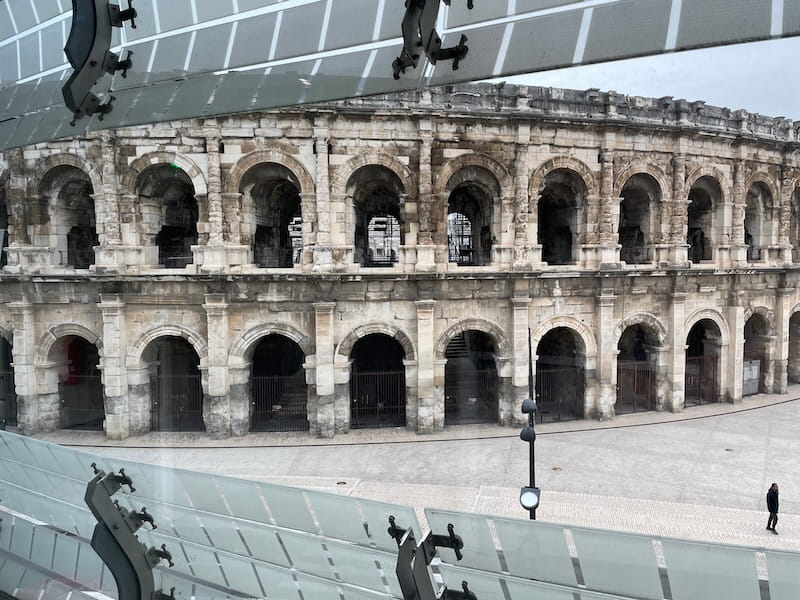 The Nimes Arena is one of the most famous monuments in France dating back to Roman times (seen here from the windows of the Musée de la Romanité across the street) ©OffbeatFrance
The Nimes Arena is one of the most famous monuments in France dating back to Roman times (seen here from the windows of the Musée de la Romanité across the street) ©OffbeatFranceThe Amphitheater of Nîmes (also known as the Arena) is a perfectly symmetrical piece of Roman engineering and one of the most exquisitely preserved Roman ruins in France. (There are several others nearby, my favorite being the Arles Amphitheater.)
It has served many purposes, from fortress to bullring to village – yes, at one point it housed a neighborhood with houses built right within the structure, a custom that seems common among such arenas. It has, of course, also been used as a location for films and photo shoots.
Bullfights are still allowed in parts of southern France as reflections of the region's "cultural heritage". Although France does have laws against animal cruelty, many, especially locally, want to maintain the sport. Like many things here, the debate continues. And yes, some bulls are allowed to be killed in French bullfights, although not in all.
The entrance of the Arena pays homage to Nimeño II, a French bullfighter whose claim to fame is the single-handed defeat of six bulls. However, the bulls returned the honor and in 1989 he was thrown into the air by one and fell on his head, damaging his cervicals and, to great medical surprise, surviving to regain partial mobility. Sadly, his left arm never recovered and he eventually committed suicide. His memory lives on, with many public areas bearing his name.
His nickname? "The Hero".
Get your tickets here for Nîmes attractions.
27. Notre-Dame de la Garde Basilica, Marseille
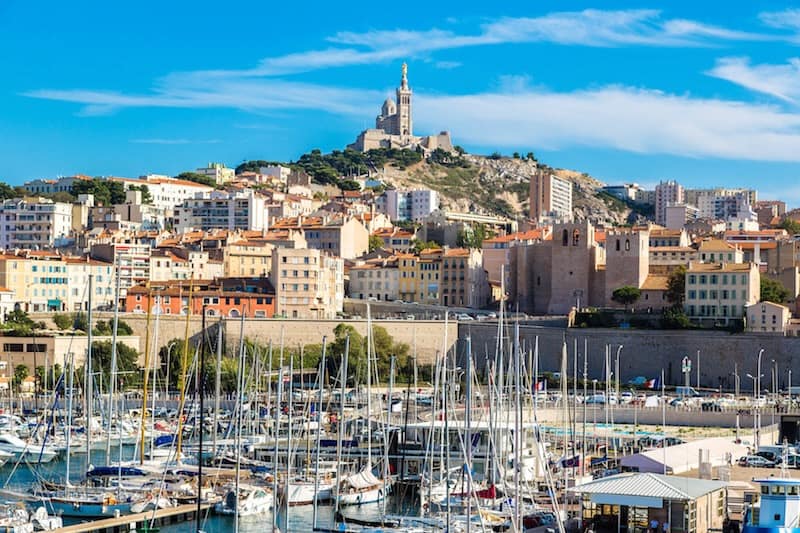 Notre-Dame de la Garde in Marseille watches over the city from its perch at the top of the Colline de la Garde
Notre-Dame de la Garde in Marseille watches over the city from its perch at the top of the Colline de la GardeArriving in Marseille, your eyes are inevitably drawn up the Colline de la Garde, towards the basilica, known locally as the “Bonne Mère”, or Good Mother.
And once you’re up there, the sweeping view of Marseille and its bay are every bit as striking, having served as a lookout for centuries.
It seems as though when something is built in France, Francis I is somehow behind it. And this is what happened here. On a visit to Marseille, the king noticed Marseille was poorly defended and built a fort on the hill, which became part of the city’s maritime defenses.
Parts of the fort are still there, and successive chapels were built on the site, culminating in 1853 with the building of the basilica.
28. Notre-Dame de Paris
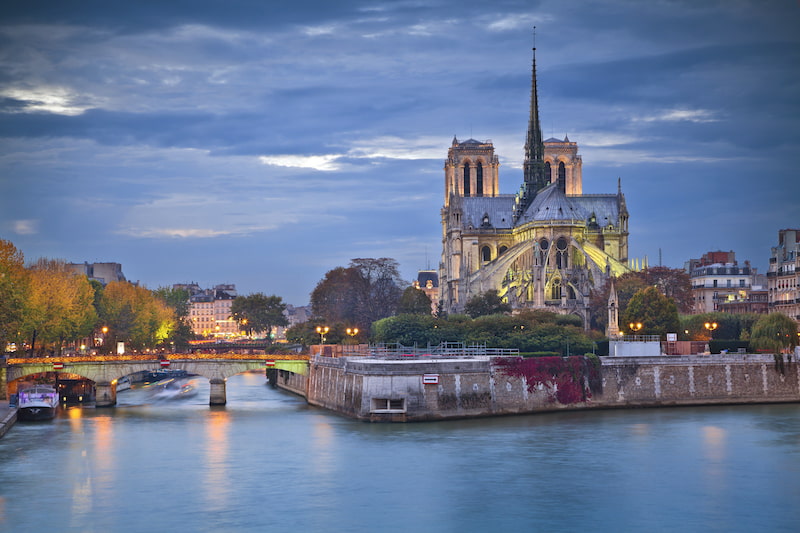 Notre Dame de Paris, before the fire
Notre Dame de Paris, before the fireNotre-Dame Cathedral, or "Our Lady of Paris", may well be the most visited monument in France – I say "may be" because many wonderful Parisian landmarks have at some point claimed that title: the Eiffel Tower, Arc de Triomphe, the Louvre... No matter. Notre-Dame is stunning, it is much loved, and few visitors to France have ever passed it by willingly.
The outpouring of affection for this 900-year-old church was obvious when fire struck it in 2019, destroying its roof, weakening the upper walls and collapsing its beloved spire, erected during the major 19th-century renovations by noted French architect Viollet-le-Duc, a specialist in restoring medieval buildings, especially those defaced or damaged during the French Revolution.
The spire, by the way, was crowned by a rooster decorated with what is believed to have been a piece of the Crown of Thorns...
Notre-Dame was built on top of two earlier churches, themselves constructed over a Roman temple to Jupiter. Its first stone was laid in 1163 but it would take nearly 200 years to complete.
Over time, though, the structure deteriorated. During the French Revolution, which was as anti-clerical as it was anti-monarchist, the statues along the main facade had been beheaded. Revolutionaries thought they represented Kings of France – in fact they represented Kings of Judea. But decapitating monarchs was popular then... (If you're curious about other corners of Paris linked to the French Revolution, here are some excellent Revolutionary tours if you happen to be in the capital.)
Eventually used as a warehouse, Notre-Dame was rehabilitated by Napoleon, who crowned himself Emperor within its walls. Victor Hugo made it even more popular in his book, The Hunchback of Notre-Dame, which is believed to have inspired Viollet-le-Duc.
The cathedral is still being repaired after the fire and is expected to reopen after the Paris Olympics, around December 2024.
29. Notre-Dame de Strasbourg
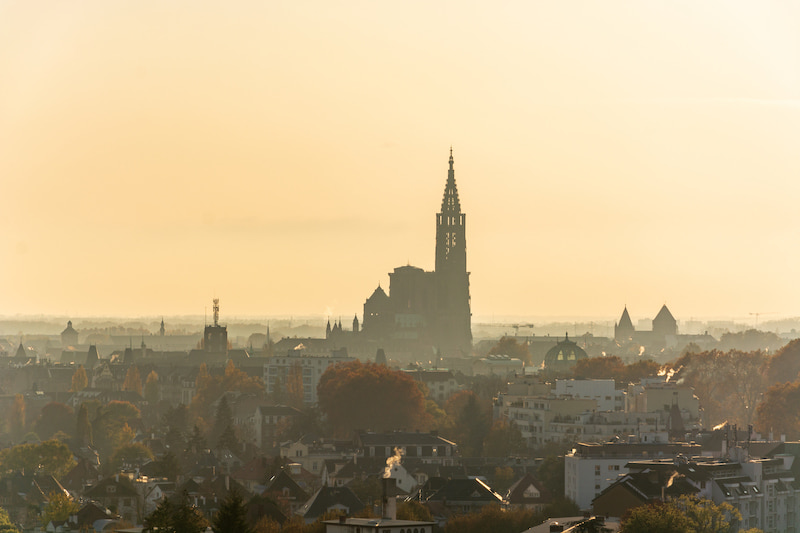 Strasbourg Cathedral has an unusual silhouette with its single tower and spire
Strasbourg Cathedral has an unusual silhouette with its single tower and spireThis Gothic cathedral is the second most-visited cathedral in France (after Notre-Dame in Paris, bien sûr!) Like most Gothic cathedrals, it took several centuries to complete.
The tallest structure in the world for more than 200 years, it, too, benefited from Victor Hugo’s admiration: he called it a "gigantic and delicate marvel".
While other churches have surpassed it in height, it still remains the tallest church ever built entirely during the Middle Ages. It may look a little lopsided (it has only one tower and spire) but a companion spire had been planned.
It was never built and no one really knows why: it could be lack of money, an aversion to massive religious spending during the Reformation, or perhaps it was decided that the foundations could not bear the extra weight. The mystery subsists.
Like many of France’s major churches, it is protected on UNESCO’s World Heritage List, but did come close to disaster during the French Revolution. A number of the church’s important statues were destroyed during the troubles, but the spire managed to escape damage. It was slated for destruction but local authorities cunningly coiffed it with a metallic Phrygian bonnet – the telltale red French revolutionary hat derived from the Phrygians who once occupied parts of modern-day Turkey – thus saving it from ruin.
30. Palais Garnier
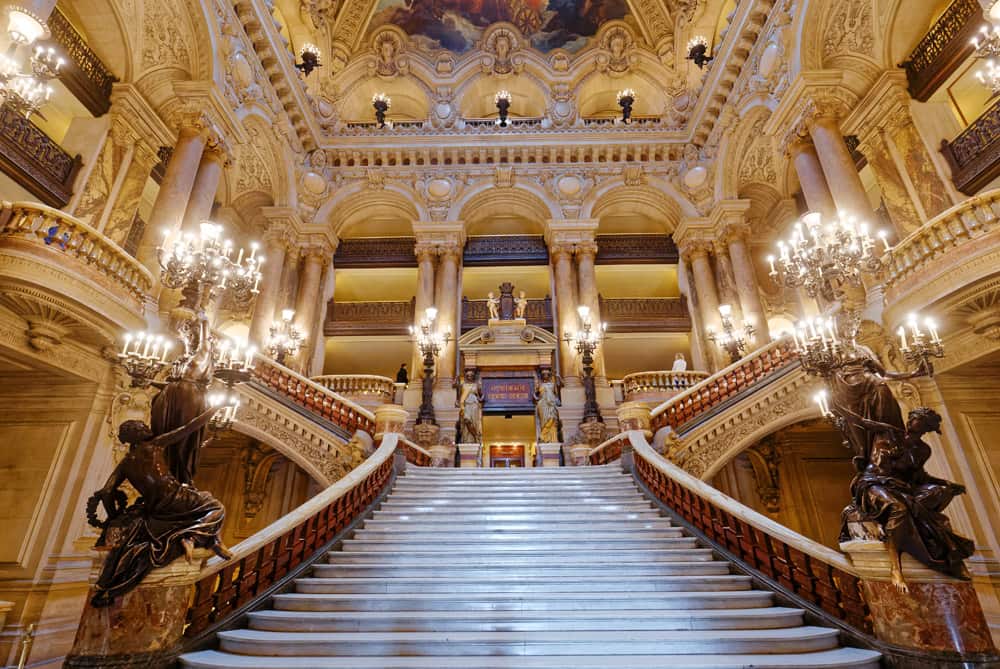 The grand monumental staircase inside the Palais Garnier, one of the most remarkable historical sites in France
The grand monumental staircase inside the Palais Garnier, one of the most remarkable historical sites in FranceDepending on your taste, this is probably one of the most stunning and over-the-top opulent buildings in France (at least I think so).
Now a national theater and music and operatic academy, it was for years known as the Paris Opera (until the new opera opened on Place de la Bastille).
Built during the great Haussmannian era under Napoleon III (when great swathes of Paris were razed to make room for elegant, classical structures), the Opera – designed by architect Charles Garnier – has become famous for more than its architecture and sweeping staircase: it is the setting for “The Phanthom of the Opera”, both the 1910 novel and subsequent musical.
And yes, there is a secret underground lake below the building, but it’s not so secret: it’s a hidden cistern filled with water which helps stabilize the building and is used as a water reservoir by the Paris fire brigade.
31. Pantheon
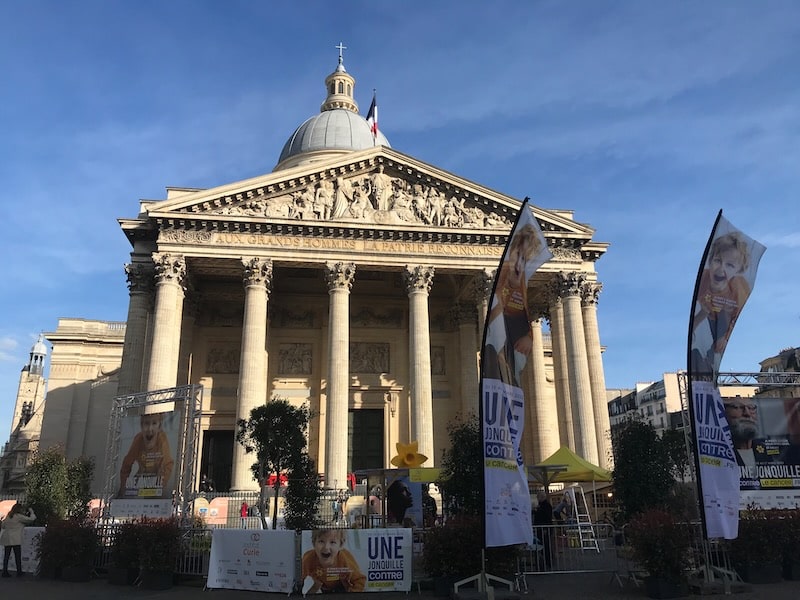 It's easy to imagine that the Paris Pantheon was once a church
It's easy to imagine that the Paris Pantheon was once a churchWe owe this building to Louis XV, who raised the funds to build a church in honor of Sainte Geneviève, the patron saint of Paris. It was completed in 1790, but the French Revolution stripped it of religious meaning. Instead, it became a necropolis for France's most illustrious men, like Voltaire and Rousseau (only six women are buried in the Pantheon, the first only in 1907).
When Napoleon came to power, he devolved the Pantheon to the Catholic Church, but the crypt remained. And so it went, from secular building to church and back again a few times until Victor Hugo's funeral in 1885. From then on, the Pantheon would remain a crypt.
The latest remains to be entombed here are those of actress Josephine Baker in 2021, bring to 81 the total number of people whose remains rest here.
32. Père Lachaise Cemetery
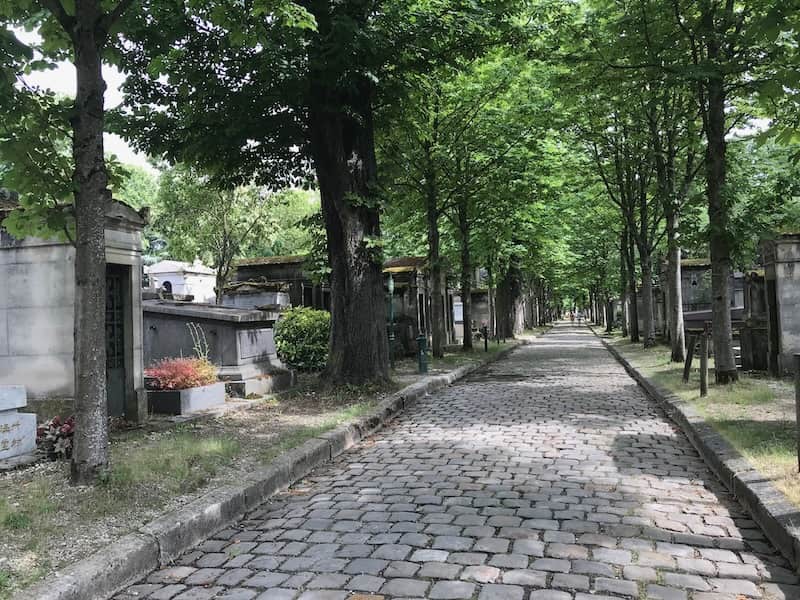 While some people come to pay their respects, many come for the feeling of serenity they experience along the alleyways of the Père Lachaise ©OffbeatFrance
While some people come to pay their respects, many come for the feeling of serenity they experience along the alleyways of the Père Lachaise ©OffbeatFranceIf you’ve ever visited this cemetery, you’ll know what I mean when I talk about its aura of peace (not unusual for a cemetery but particularly evident here).
It’s the largest cemetery in Paris and the most visited in the world, marginally for its intriguing graves and tree-lined alleys but mostly for a brush with the many celebrities buried here, ranging from Jim Morrison of the Doors to actress Sarah Bernhardt, from poet Oscar Wilde to composer Chopin.
33. Place Stanislas, Nancy
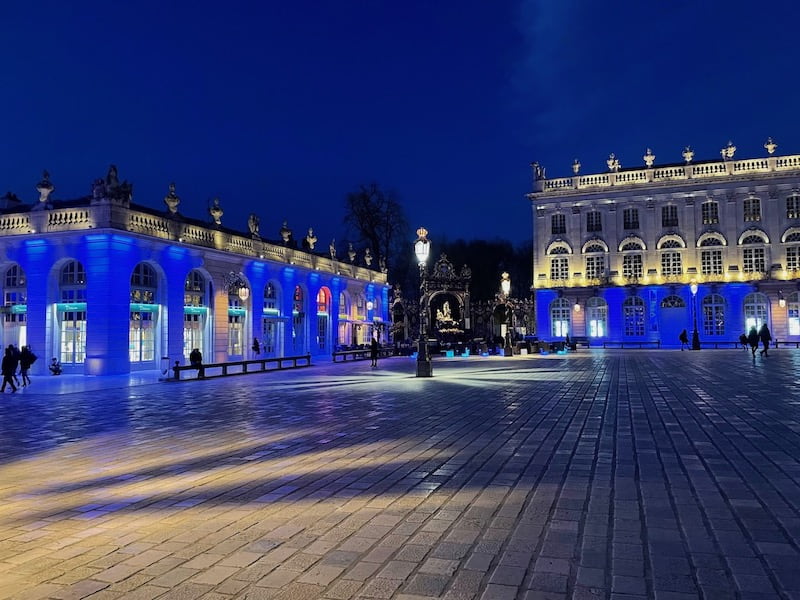 Place Stanislas in Nancy at the blue hour ©OffbeatFrance
Place Stanislas in Nancy at the blue hour ©OffbeatFranceThis square is in the eastern city of Nancy, known for its Art Nouveau heritage. The Place Stanislas is as beautiful in daytime as it is at night, so it's no wonder that France voted it as its favourite monument in 2021.
You could spend the entire day and evening here and find plenty to do and see, but it also has huge historical significance, named for a Polish ex-king who became the last Duke of Lorraine and father-in-law of Louis XV. Here's the full story of Place Stanislas.
34. Pont d'Avignon
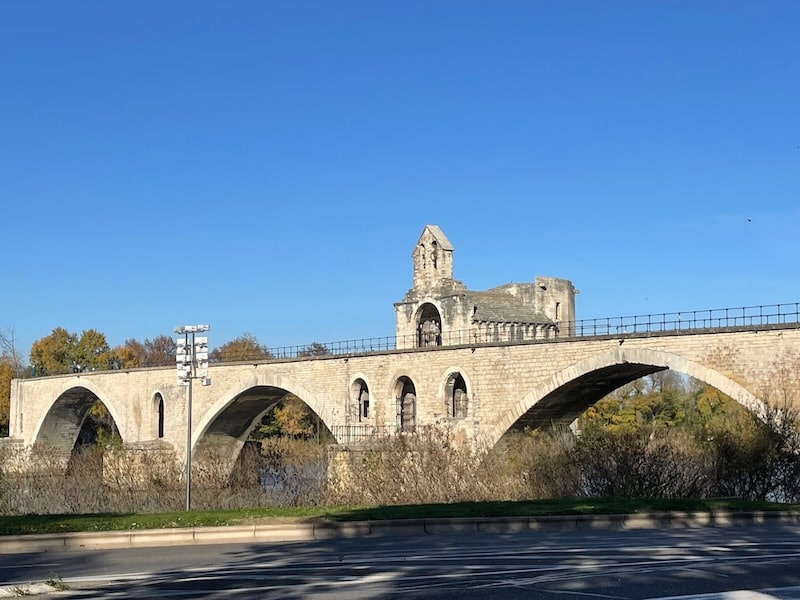 Le Pont d'Avignon, or Avignon Bridge (or, more officially, the Pont Saint-Bénézet), stops abruptly in the middle of the Rhône ©OffbeatFrance
Le Pont d'Avignon, or Avignon Bridge (or, more officially, the Pont Saint-Bénézet), stops abruptly in the middle of the Rhône ©OffbeatFranceEvery French child knows the Pont d'Avignon – it's one of the most famous bridges in France because of the song: "Sur le pont d'Avignon, on y danse, on y danse..."
It's one of the first songs we learn, somewhere between Happy Birthday and Frère Jacques.
According to the song's lyrics, everyone dances ON the bridge. But the bridge was narrow, and people danced UNDER it, where all the revelry took place. The song was slightly inaccurate.
The bridge no longer spans the Rhône River, as it once did, stopping about halfway. It had 22 arches, but constant flooding kept washing away parts of the bridge. Eventually, the people of Avignon decided enough was enough, and they let it be, rebuilding another bridge further down the river where it flowed more slowly.
Yet if the current was so harsh here, why was this specific spot chosen in the first place?
Because of Saint Bénézet. Back in medieval times, a boy tending his flock heard voices. "Go build a bridge," the voices said. "Build it there, where the river is swiftest."
The shepherd persevered, the bridge was built, and he was eventually sainted. Of course legends are legends, but this one at least explains why the bridge appeared here in the first place, over time becoming one of the most famous French monuments...
Avignon walking tour including the bridge
35. Pont du Gard
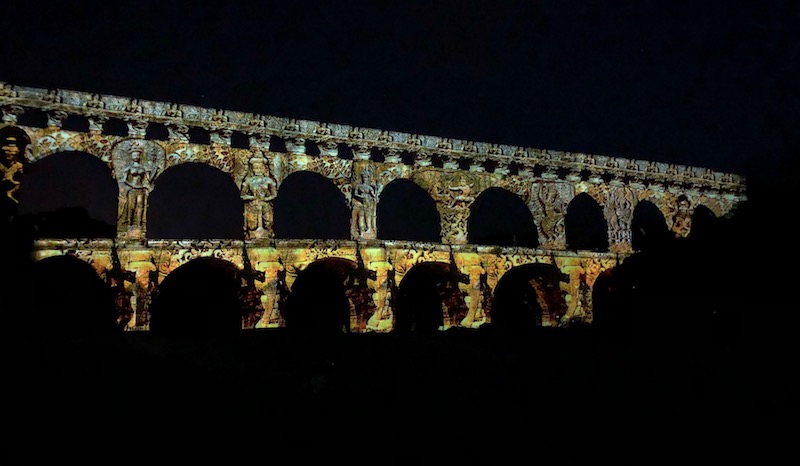 Le Pont du Gard and its night light show ©Le Long Weekend
Le Pont du Gard and its night light show ©Le Long WeekendThe Roman Pont du Gard is a famous France landmark for anyone interested the country's roman ruins or Gallo-Roman history. It stands a towering 50m (165ft) tall over the river Gardon, near Uzès in the Occitanie region of France, just a short drive from Avignon.
It's a stunning feat of engineering (or, if you believe local legend, the result of a pact with the devil) that encompasses three different levels, and 42 arches of differing sizes.
Every night during summer, you can visit the site in the early evening, and explore the walking tracks around the bridge, take a tour of the top level, dine in the onsite eateries, or take a summer nights' swim, before finding a suitable perch on the grassy bank to watch a grand spectacle, the à la Belle Etoile event, that starts as soon as the sun goes down.
Lights illuminate the bridge, displaying both modern and ancient works of art, in sync with music. It's a truly moving and entertaining performance that lasts around half an hour.
The Pont du Gard, built in the first century CE, also happens to be one of the best-preserved ancient ruins in France, the world's highest Roman aqueduct, and the only three-story Roman arch still standing today.
If you happen to visit during the day, look closely for the petroglyphs, or rock art, which reflect stories and legends, including a petroglyph of either a cat or a hare, depending who you listen to.
Everyone, however, agrees the devil was involved. Noting the slow pace of building, he allegedly offered to help build the bridge in exchange for one thing: the first person to cross the bridge would belong to him.
Once the bridge was finished, someone released a cat - or a hare - who ran across the bridge and straight into the Devil's arms. The Devil, furious at being tricked, flung the animal against the wall, resulting in the now-famous petroglyph.
Take a day trip from Avignon to the Pont du Gard and Saint-Rémy.
36. Promenade des Anglais, Nice
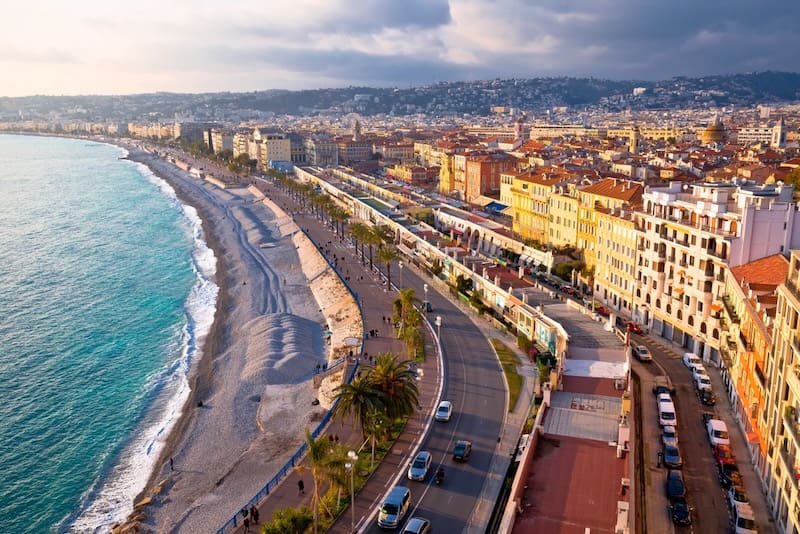 The Promenade des Anglais, all along the beach
The Promenade des Anglais, all along the beachWho hasn’t admired the sweeping 7-kilometer (4.3 miles) walkway along the Bay of Angels in Nice?
What started out as protection against storms and pirates would eventually become one of the world’s most famous and beloved boardwalks, the Promenade des Anglais, or the Boardwalk of the English.
Wealthy English winter tourists began arriving during the 1760s, and to help reduce the poverty that had taken hold of the city, an Anglican pastor began raising money to help the city’s poor earn a wage by leveling a stretch of road near the water.
This stretch became identified with the English, and when it was extended by subsequent administrations, the name stuck. The English would finally have the path they had so wanted for long and the healthy walks along the sea, building sumptuous villas along the way. Sadly, most of these are gone.
As for the boardwalk, it would slowly be extended and widened, giving us the broad elegant swathe we have today and contributing to making Nice a favorite southern France town.
37. Reims Cathedral
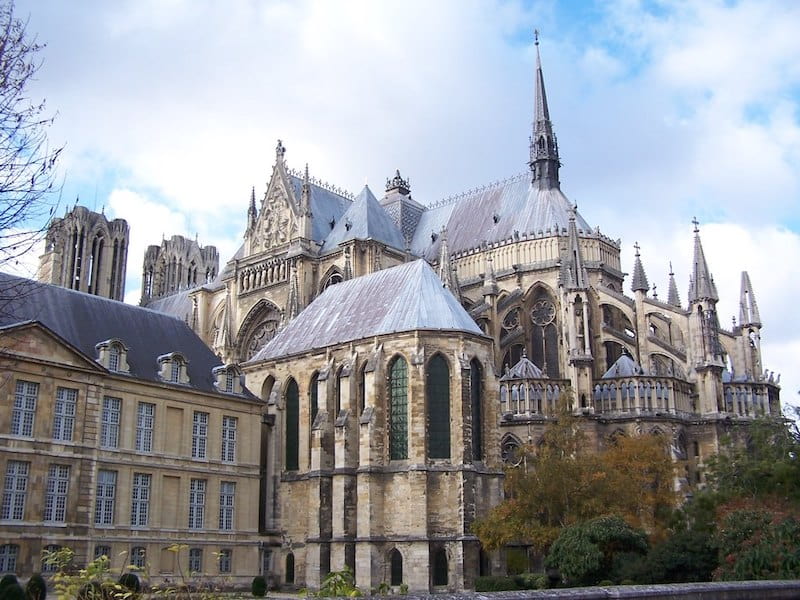 Reims Cathedral, where Charles VII was crowned after Joan of Arc defeated the English and handed him a victory
Reims Cathedral, where Charles VII was crowned after Joan of Arc defeated the English and handed him a victoryVisitors usually head for Reims in search of champagne, but they often detour via the High Gothic Reims Cathedral, which has a major claim to historical fame: this is where most of France’s kings were crowned, including the fifth-century King of the Franks, Clovis, heralding the birth of the kingdom of France.
This is the church to which Joan of Arc led Charles VII for his coronation, after defeating the English in battle despite unspeakable odds.
The cathedral also contains more statues than any other church in the world: 2303. It also happens to be larger and older than Notre-Dame in Paris…
38. Royal Saltworks of Arc-et-Senans
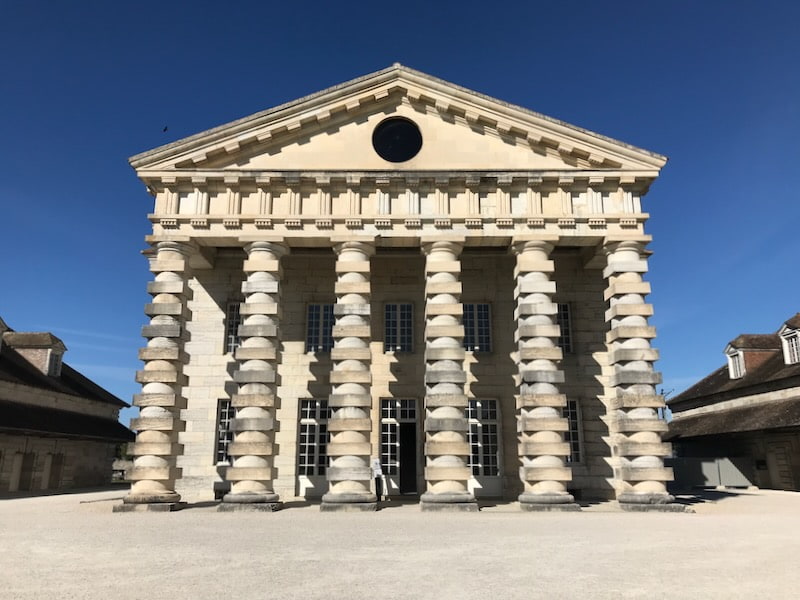 The unusual architecture of the saltworks at Arc-et-Senans, dating back to the 18th century
The unusual architecture of the saltworks at Arc-et-Senans, dating back to the 18th centuryThis is one of the more unusual places in France I’ve come upon, utterly unexpected and eye-opening. Commissioned under Louis XV, this salt-processing plant in the Jura Mountains is a visual surprise.
Built by architect Claude-Nicolas Ledoux, the buildings – designed as a massive semi-circle – are surprising, especially for something dating back to the 18th century.
Once the mountain salt industry began to die as a result of competition from cheaper sea salt, the saltworks were deprecated and almost destroyed a few times but somehow managed to become officially listed as a national monument in 1926.
Over the years, the complex would be a horse farm, a refugee camp, an army barracks, a holding center for Roma and other Central European nomads, and a prisoner-of-war camp. Today, it is on the UNESCO World Heritage List and contains an intriguing museum dedicated to Ledoux.
39. Sacré-Coeur Basilica, Montmartre
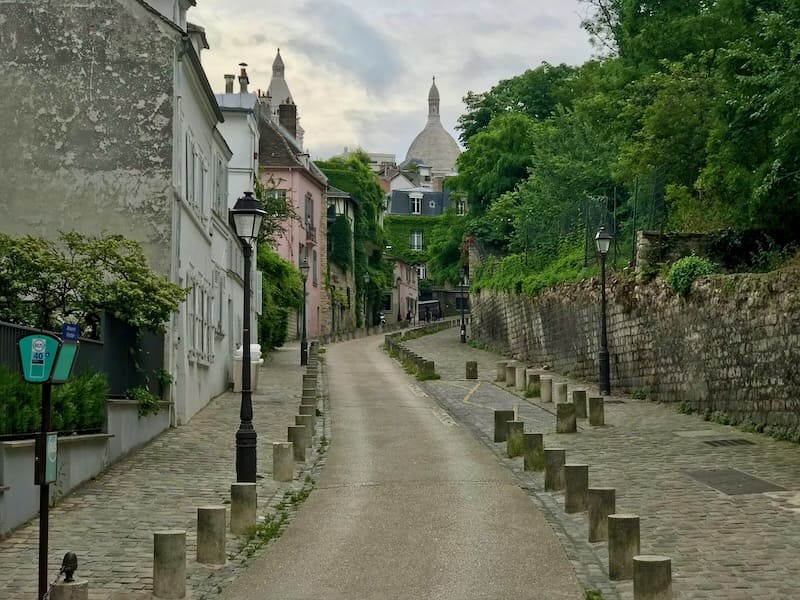 Rue de l'Abreuvoir, one of Montmartre's most iconic streets, with Sacre Coeur Basilica in the background ©OffbeatFrance
Rue de l'Abreuvoir, one of Montmartre's most iconic streets, with Sacre Coeur Basilica in the background ©OffbeatFranceSince the time of the Druids, Montmartre has been a place of worship, so the decision to build a basilica at the top of the hill is no surprise.
A first chapel was built here in honor of St Denis, a 3rd-century martyr determined to convert Roman Gauls to Christianity, becoming the first bishop of Paris. He was decapitated by the Romans for his evangelical work, and died on Montmartre (which means “mountain of martyrs”).
This is an aside, but according to legend, Denis (not yet a saint) picked up his severed head and carried it under his arm for six kilometers (3.7 mi) to his final resting place, where a church dedicated to him would eventually be built: the Basilique Saint-Denis, which houses the remains of 42 kings, 32 queens, and 63 princes and princesses.
But back to Montmartre. A number of healing incidents and miracles took place in the chapel on the hill, and an abbey was built, expanding its prestige.
This grew until – you guessed it – the French Revolution, when the abbey was destroyed. By 1870, France had lost the Franco-Prussian War and a group of faithful decided that building a church would help atone for the sins which had surely caused the defeat (and plenty of other ills).
Money was raised across France for the building, which was dedicated to the “sacred heart of Christ”, contrary to many of the contemporary churches dedicated to Mary, his mother.
The cornerstone was laid in 1875, and the building officially completed in 1923.
40. La Sainte-Chapelle
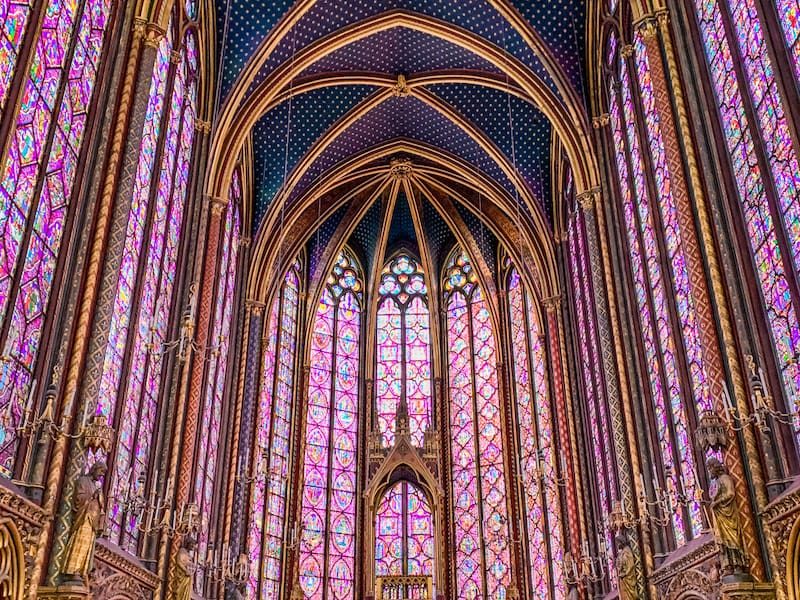 The Sainte-Chapelle, one of the most exquisite historical landmarks in France ©Limitless Secrets
The Sainte-Chapelle, one of the most exquisite historical landmarks in France ©Limitless SecretsThe Sainte-Chapelle is in the medieval Palais de la Cité, the residence of the kings of France, on the Île de la Cité. It was built in the first part of the 13th century to host King Louis IX's collection of passion relics, including Christ's crown of thorns. It was a sort of vault, a place to store the sacred relics Saint-Louis had "brought back" during the Crusades.
The chapel was built on two levels. The lower level was where the courtiers, servants, and soldiers of the palace lived. The upper level was reserved for the royal family and their guests − and for the sacred relics.
What makes this such a famous building in Paris is the magnificent stained glass that covers much of the chapel's walls: 15 windows, each 15 meters high, covering 670 square meters and featuring 1,113 scenes from the Old and New Testaments, as well as the history of the world until the relocation of the relics in Paris.
The Sainte-Chapelle is a true jewel of the Rayonnant style, the height of Gothic architecture, and one of the most famous monuments in France, not just Paris.
But its survival wasn't always a given.
In its lifetime, fire struck this jewel several times, the largest of which were in 1630 and 1777. It was flooded. It was ransacked and its interior stripped during the French Revolution.
Although much of the chapel was restored during the 19th century, (some of) the impossibly beautiful original stained glass windows survived. The techniques used back in the 13th century were so perfect some colours still cannot be reproduced today.
And another thing: those stained glass windows were more than decoration.
In those days, few people could read, and the windows told stories, their finely cut designs depicting scenes from Christian belief − the religious picture books of the era.
Reserve your ticket for the Sainte-Chapelle.
41. Trianon Estates
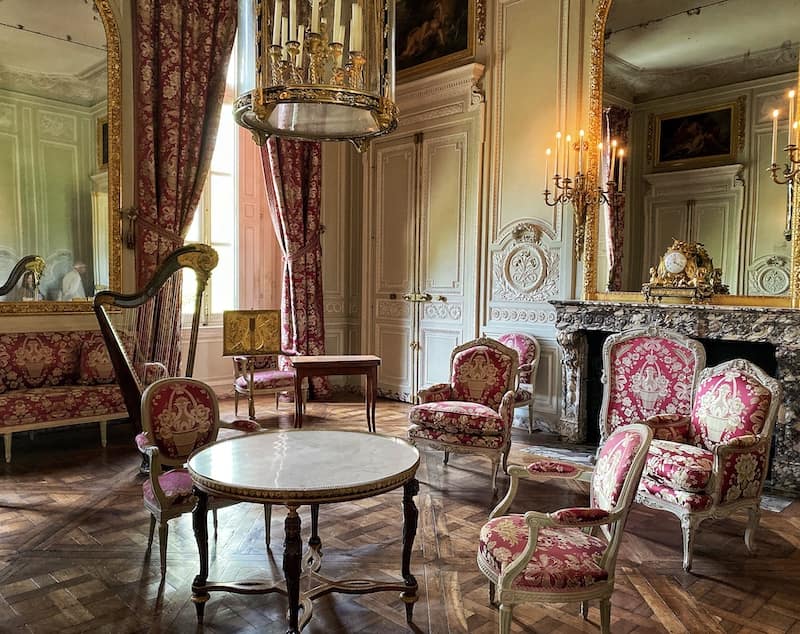 Inside the Grand Trianon, near the Palace of Versailles ©Claudia Tavani
Inside the Grand Trianon, near the Palace of Versailles ©Claudia TavaniThe Trianon Estates are often overlooked by people visiting Versailles, one of the most famous landmarks of France. Yet they are a lovely surprise and – in fact – a nice and lesser crowded alternative to the most famous château in France.
The estate is made up of the Petit and the Grand Trianon, both of which were built to help royalty escape the strictures and incessant gossip of nearby Versailles.
Louis XIV commissioned the building of the Grand Trianon in 1687, as a way of escaping his courtiers and the pomp and rules of Versailles (which he was responsible for instituting, by the way), and especially as a way of pursuing his extramarital affair with Madame de Montespan, who bore him seven illegitimate children.
The Grand Trianon – also called the Trianon of Marble – is also where Napoleon chose to live with his second wife, Marie-Louise (coincidentally, she was Marie-Antoinette's great-niece), preferring it to Versailles.
The furnishings date back to the First Empire, under Napoleon, since the originals were destroyed during the Revolution.
As for the Petit Trianon, it was built in 1758 by Louis XV, who wanted to be close to the gardens so he could indulge in his botanical interests.
But it really came into its own when in 1774 Louis XVI gave it to his wife, Marie-Antoinette, who used it as a retreat to escape the life, gossip and strict rules of nearby Versailles, and redecorated it extensively. The three-story building is famous for its magnificent wrought iron bannister.
During the Revolution, the good people of Paris wanted to break up the Trianon gardens and sell them at auction. But the original gardener's son, Antoine Richard, came up with a brilliant idea: he planted rows of fruit trees and vegetable plants along the canal and around the grounds. These provided food for the population, and there was no more talk of destroying the gardens, which were saved.
You can visit the Trianon Estates during your exploration of Versailles if you have an all inclusive ticket, but you can also decide to visit them separately if you wish.
Visit Versailles and the Trianon Estates from Paris.
42. Versailles
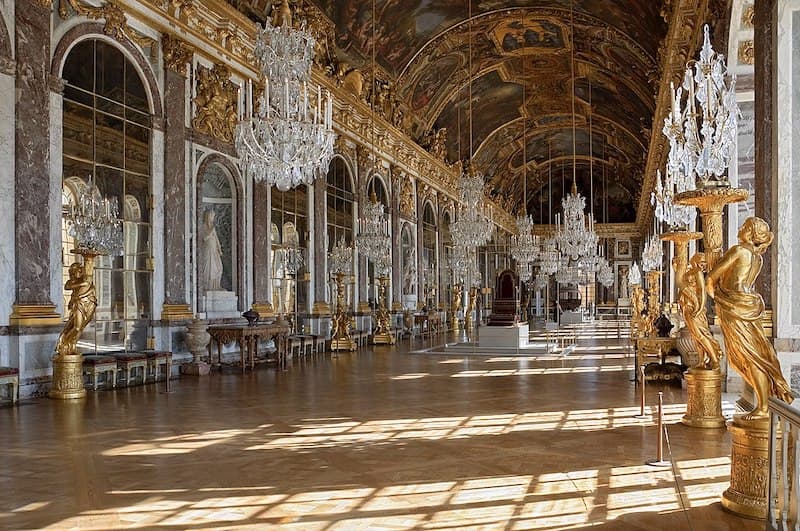 The very over-the-top Hall of Mirrors at Versailles Palace
The very over-the-top Hall of Mirrors at Versailles PalaceSurely Versailles requires no introduction – château, historical monument, home of kings, court and government of France, site of Wilhelm of Prussia’s coronation as German emperor, seat of the National Assembly, and site of the signature of the Treaty of Versailles, celebrating German’s defeat.
The château is an architectural and artistic jewel that goes far beyond its 2300 rooms to include giant gardens, the Grand and Petit Trianon, the Queen’s village and many other sights which attract some of Europe’s largest crowds.
It is indescribable, and you have to see it to believe it.
French landmarks FAQ
What are 6 famous landmarks in France?
All 6 happen to be in (or near) Paris. They are: the Louvre, Versailles, the Eiffel Tower, the Centre Georges Pompidou, the Orsay museum, and the Arc de Triomphe.
Why should I visit famous landmarks in France?
France's famous landmarks are the gateways to the country's rich history, culture, and art, and visiting them allows you to step into different eras, marvel at human ingenuity, and gain insight into France's cultural evolution. Plus, there are so many!
What is the most famous landmark in France?
There is no "most famous" list but the one monument that keeps coming up when people think of France is the Eiffel Tower.
What is the most visited landmarks in France?
That would be the Arc de Triomphe, the Triumphal Arch that sits in the center of the Place Charles de Gaulle (formerly Place de l'Etoile). Such landmarks as the Eiffel Tower don't get counted in the lists of most visited because they are private.
Famous France landmarks: Final thoughts
By now you've seen that France is a treasure trove of remarkable landmarks that capture both its rich history and cultural heritage.
And although this list only scratches the surface, it demonstrates the incredible cultural wealth of the country.
Each of these France landmarks is an enduring part of the country's history, and every single one is, in the words of the Michelin guide, "worth the detour".
You might also like these stories!
CONTRIBUTORS
Fellow bloggers contributed to a few of the landmarks in this piece. They are: Arc de Triomphe by Journey to France (journeytofrance.com) | Sainte-Chapelle by Limitless Secrets | Trianon Estates by My Adventures Across The World (myadventuresacrosstheworld.com) | Papal Palace of Avignon by Dr Jam Travels | Pont du Gard by Le Long Weekend (lelongweekend.com) | Millau Viaduct by The Travelling Twins (the-travelling-twins.com) | Grosse Cloche by Luxe Adventure Traveler (luxeadventuretraveler.com) Villandry Gardens by Travel Ruta del Mate | Mont Saint-Michel by Guide Your Travel (guideyourtravel.com) | Meuse-Argonne American Cemetery by LeAnna Brown of Wander in Germany | Amiens Cathedral by The Travel Bunny (thetravelbunny.com) | Cap 110 Anse Cafard by A Social Nomad (asocialnomad.com) | The rest were written by Yours Truly.
Did you enjoy this article? I'd love if you shared it!
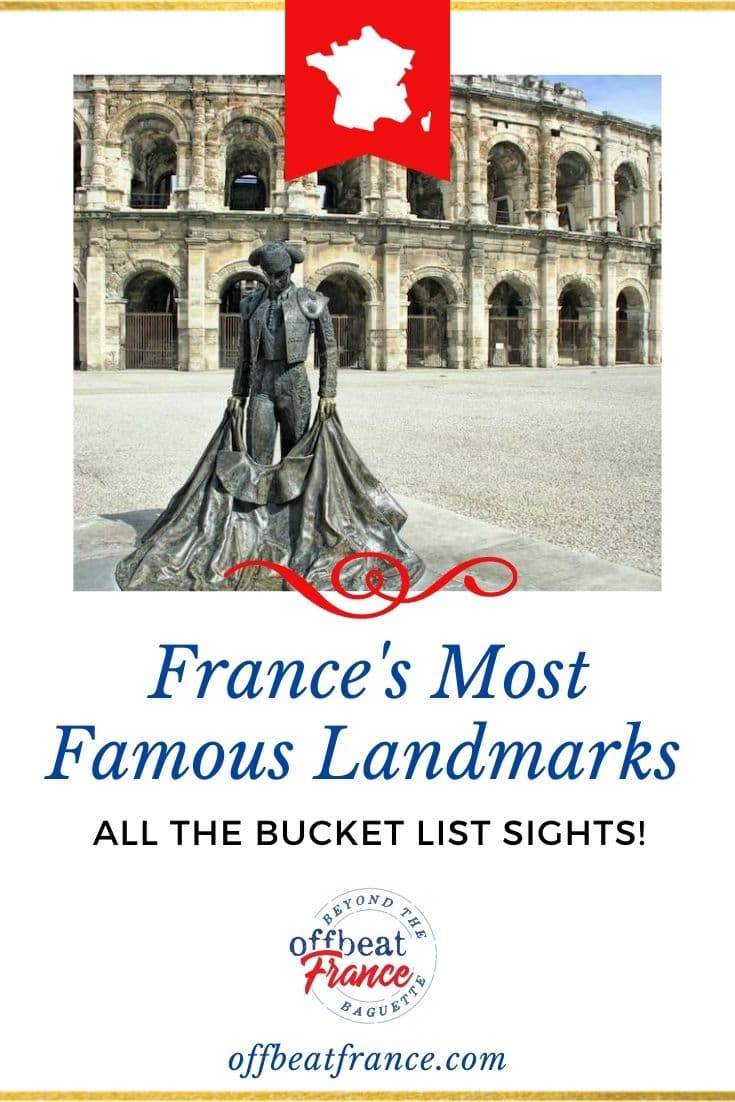 |
 |

